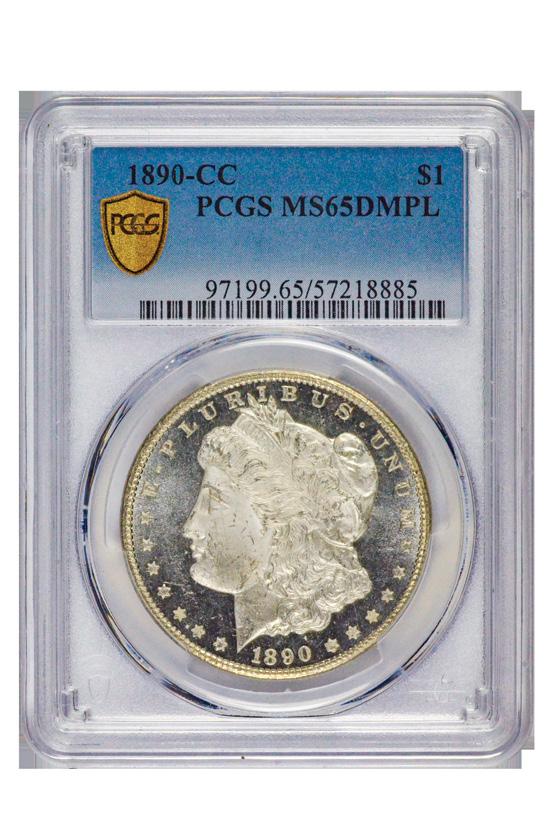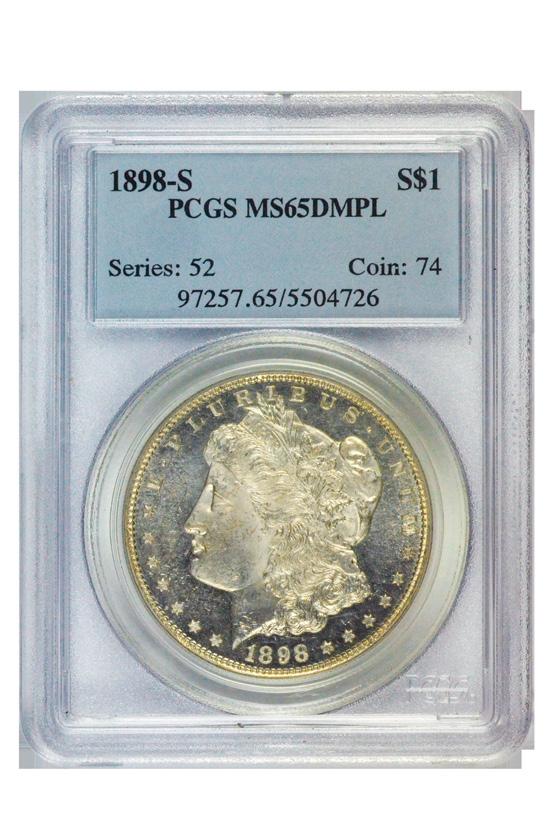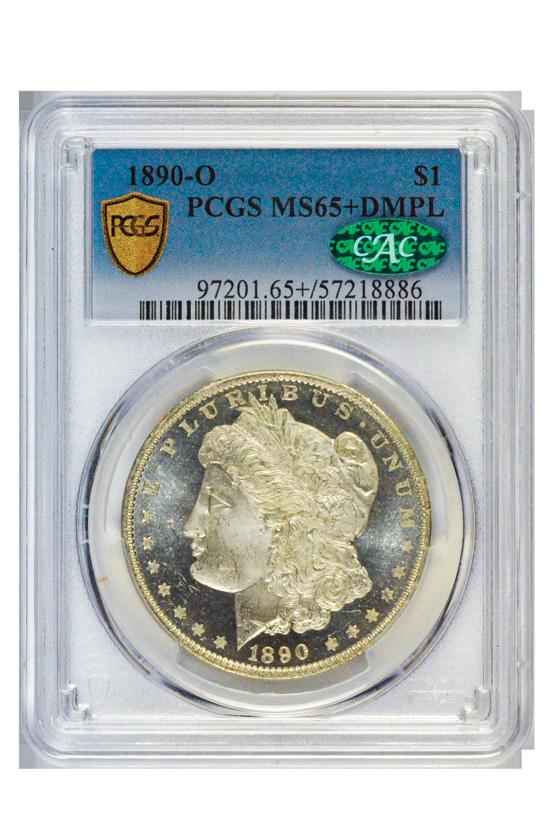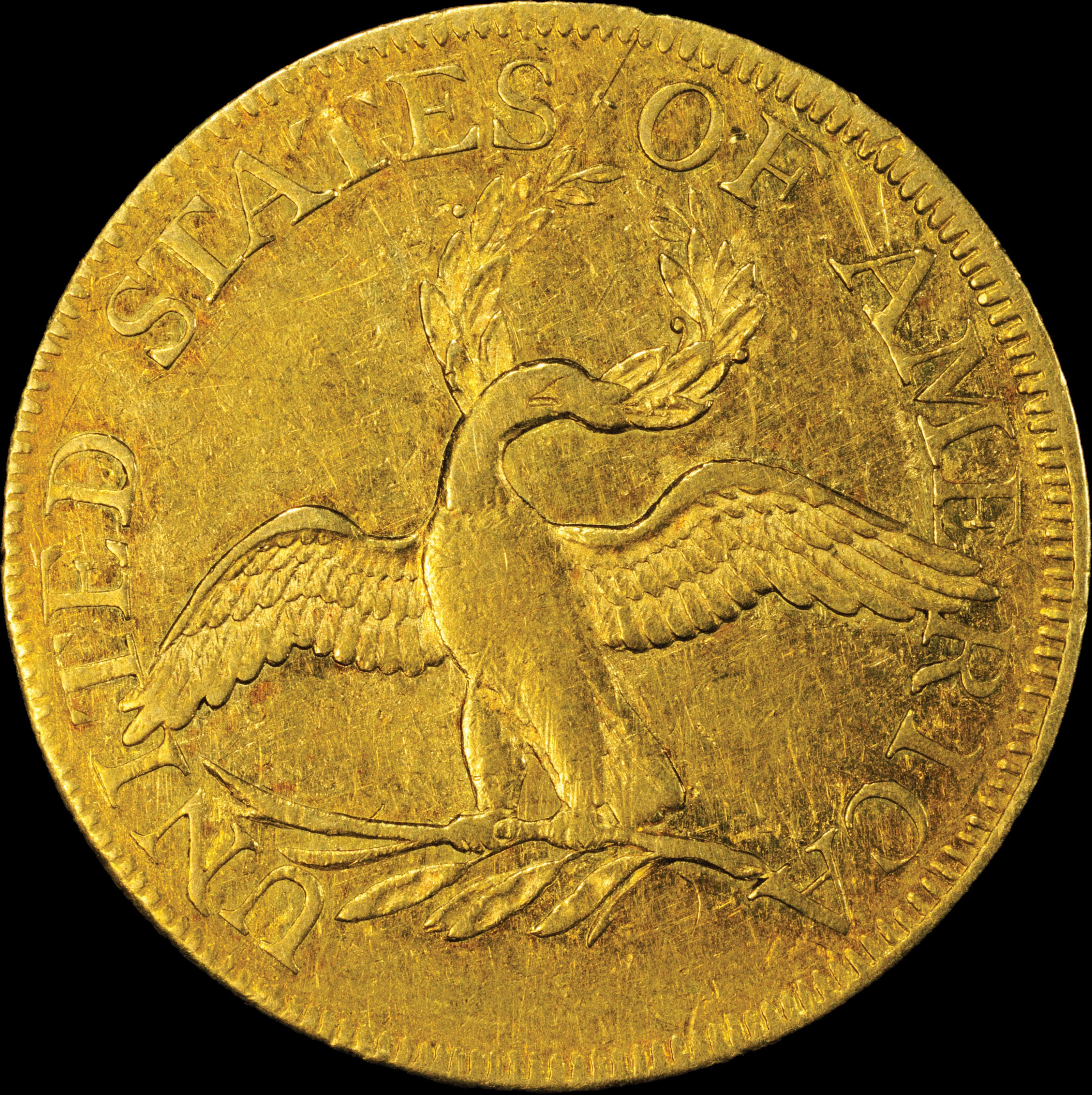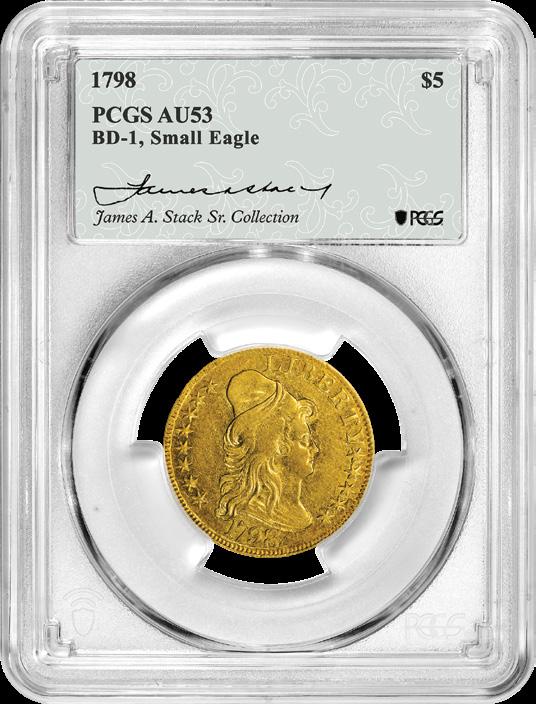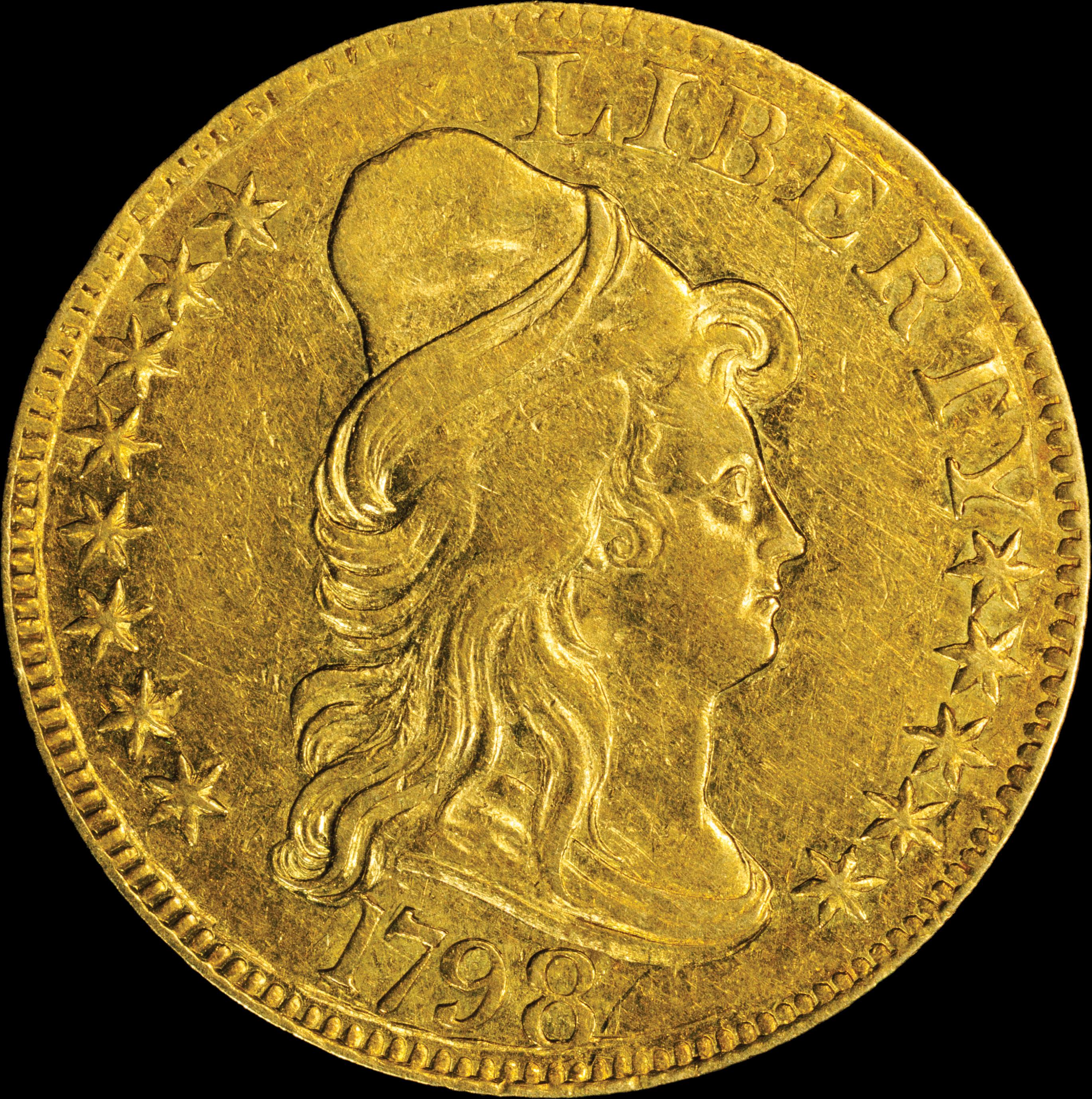
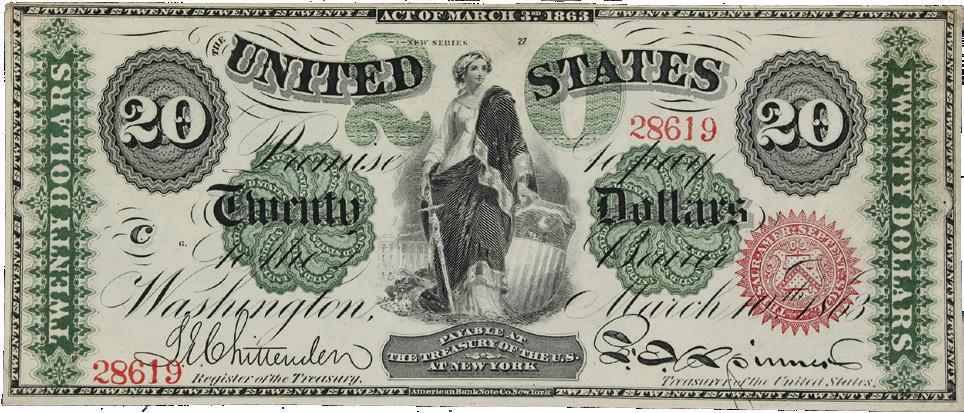

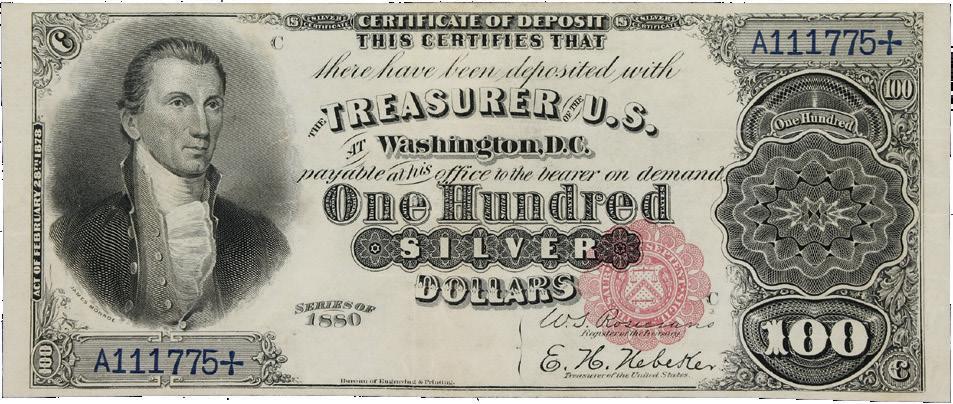
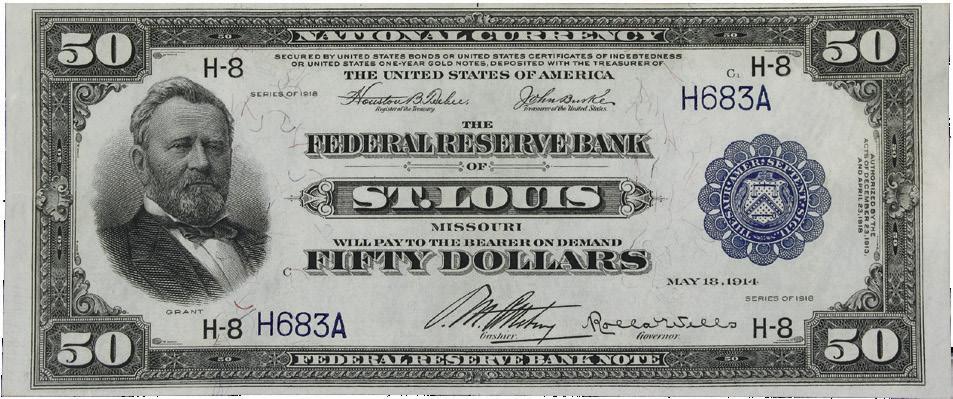
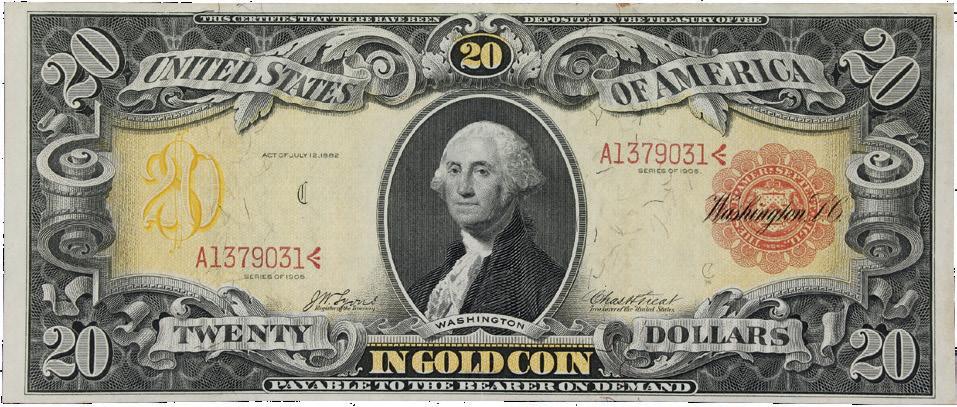

















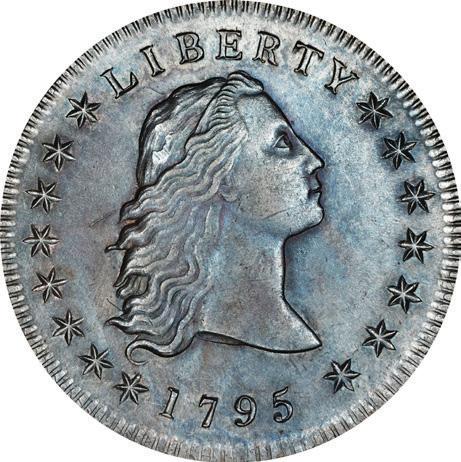

1795 Flowing Hair Silver Dollar. BB-27, B-5. Three Leaves. MS-64 (PCGS). CAC. CMQ.
From B. Max Mehl’s 1948 auction of the C.A. Allenburger Collection.
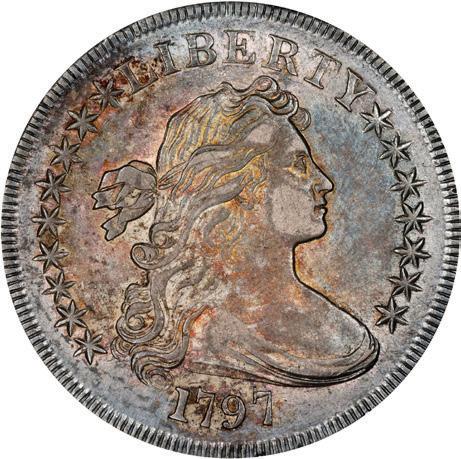
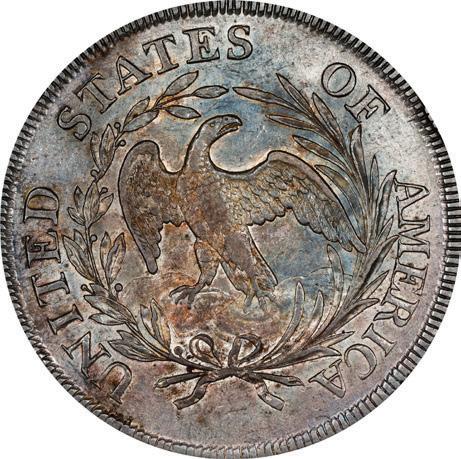
1797 Draped Bust Silver Dollar. BB-73, B-1. Stars 9x7, Large Letters. AU-58
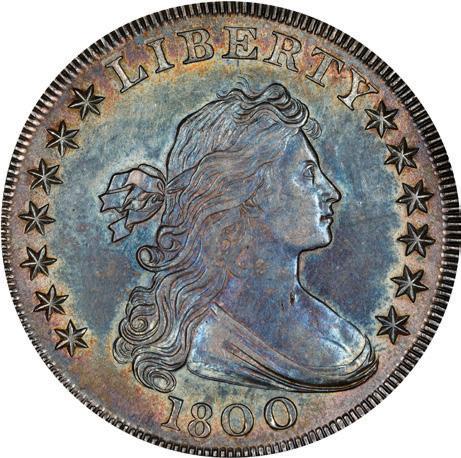

1804 Draped Bust Silver Dollar. Class III. Second Reverse. Proof-65 (PCGS) CAC. CMQ. A Previously Unpublished Specimen.
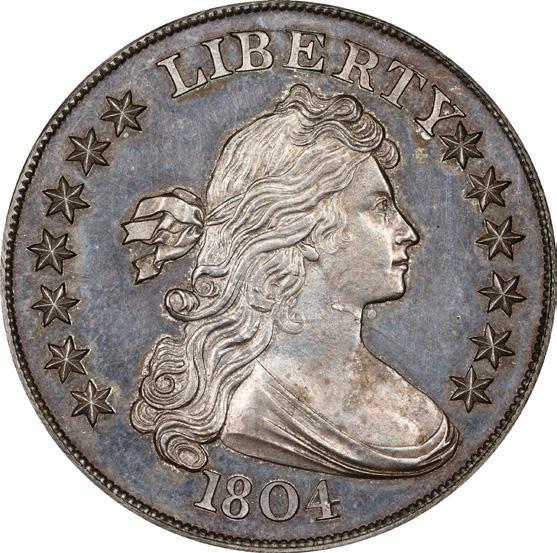
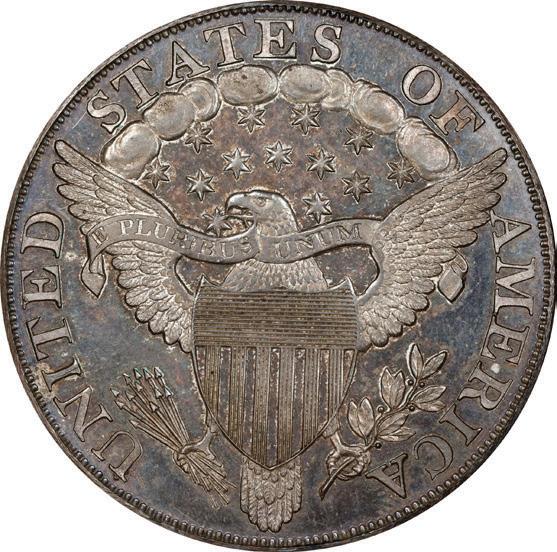
The Finest Class III Example in Private Hands.
The Only CAC Approved 1804 Dollar of any Class.

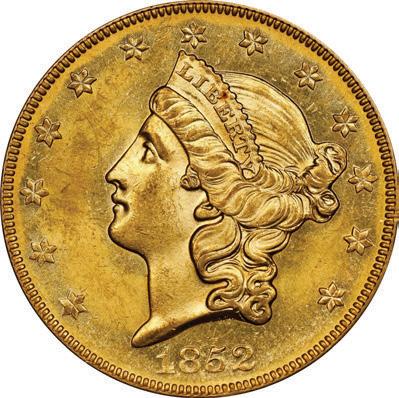
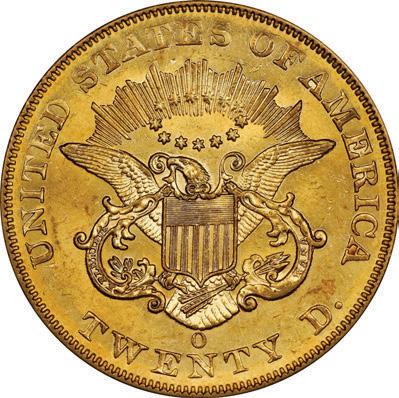




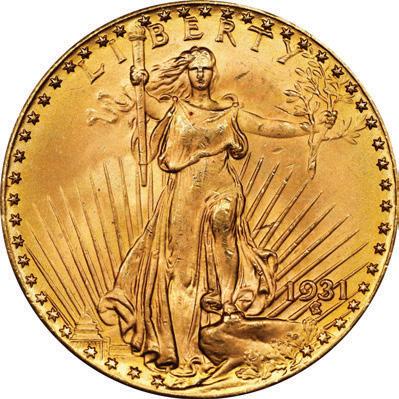


1550 Scenic Ave., Ste. 150, Costa Mesa, CA 92626 949.253.0916 • Info@StacksBowers.com 470 Park Ave., New York, NY 10022 212.582.2580 • NYC@stacksbowers.com Visit Us Online at StacksBowers.com
The year is winding down, and many in the numismatic community are spending time celebrating the holidays, meeting with family and friends, and reflecting on the successes and challenges of the waning year. Meanwhile, we at PCGS are looking forward to the coming year, when we will celebrate our company’s 40th anniversary. It’s an auspicious occasion we’ve been anticipating for a very long time. Turning 40 is a big deal, not only because of the landmark nature of such an anniversary, but also because it reminds us that the advent of third-party grading is no longer a recent phenomenon for the numismatic hobby. Generations of collectors have known PCGS, and they trust us because of the quality and consistency they’ve always known us for, as well as for our continued commitment to leading the industry to this day.
As we begin ramping up our 40th anniversary celebration, we also share here in this last issue of PCGS Insider for 2025 a multitude of articles that speak to the strength and diversity of our hobby. Perhaps one of the biggest stories to unfold as we turn the final pages of this year is the sale of the James A. Stack, Sr. Collection, being offered by Stack’s Bowers Galleries in December 2025 and February 2026. There are many highlights to share about this incredible collection and the 200 prestigious coins that will cross the block. However, one of the most incredible trophies from this majestic collection is a 1798 Draped Bust Half Eagle, Small Eagle graded PCGS AU53, being offered by Stack’s Bowers Galleries. Such coins rarely come to market, and when they do, they attract the most well-heeled and esteemed numismatic connoisseurs.
In this issue of PCGS Insider, we will also introduce you to Keith Dewald, someone whose name appears in the masthead of this magazine. His dynamic artistic talents are surely no stranger to any PCGS devotee, but until now, he has largely remained behind the scenes. We are excited that this artistic maestro finally shares his colorful and inspiring story with the world. You will also meet Allen Ross, a scholar of early American copper, and Ross Koenig, a 19-year-old numismatist whose list of numismatic achievements already rivals the depth and breadth of those held by many leading hobbyists.
Covering a variety of topics, including Mexican silver, 19th-century United States medals, classic silver dollars, rare share certificates, and much more, the November-December PCGS Insider truly has something for everyone. And as we roll into the jubilee year for PCGS, we want truly everyone to know that we are here to help protect them on their collecting journey while making the hobby more fun for them, too. That also means we are here to advocate for your collecting interests and would love to know more about the areas of the hobby you care most about. We are listening and want to make sure that, along with the many big announcements we have in store for 2026, we can help you enjoy your numismatic endeavors even more.
Happy Holidays,
Editor-in-Chief
JOSHUA MCMORROW-HERNANDEZ
Creative Director
JACK ARCHER
Art Director
GEOFF PARRISH KEITH DEWALD
Designer JAMES DAVIS
Production Artist
CHRIS WILSON
Staff Writer
SANJAY C. GANDHI
ABIGAIL ZECHMAN
EDWARD VAN ORDEN
JAY TURNER
JAIME HERNANDEZ
VIC BOZARTH
NATHANIEL UNRATH
Contributing Writer
PETER ANTHONY
CHRISTOPHER BULFINCH
Advertising
TARYN WARRECKER
ARIANNA TORTOMASI
PCGS INSIDER
PCGS Insider Magazine USPS Pending Periodical #226, Copyright © 2025 by The Collectors Universe is published bimonthly by The Collectors Universe, 1610 E St Andrew Pl, Santa Ana, California, 92705. Application to Mail at Periodicals postage is Pending at Santa Ana, CA and additional mailing offices. Printed in Canada.
Nothing herein is intended to provide financial advice. Past sales do not guarantee future results.
Send address changes to Collectors Universe, 1610 E St Andrew Pl, Santa Ana. California, 92705.
BUSINESS & EDITORIAL OFFICES
1610 E St Andrew Pl Santa Ana, CA 92705 (949) 567-1234
ACCOUNTING & CIRCULATION OFFICES
1610 E St Andrew Pl Santa Ana, CA 92705 (949) 567-1234
Call (949) 567-1234 to subscribe. Periodical postage is paid at Blaine, WA.
Joshua McMorrow-Hernandez PCGS Insider Editor-in-Chief
insider@PCGS.com / @PCGScoin

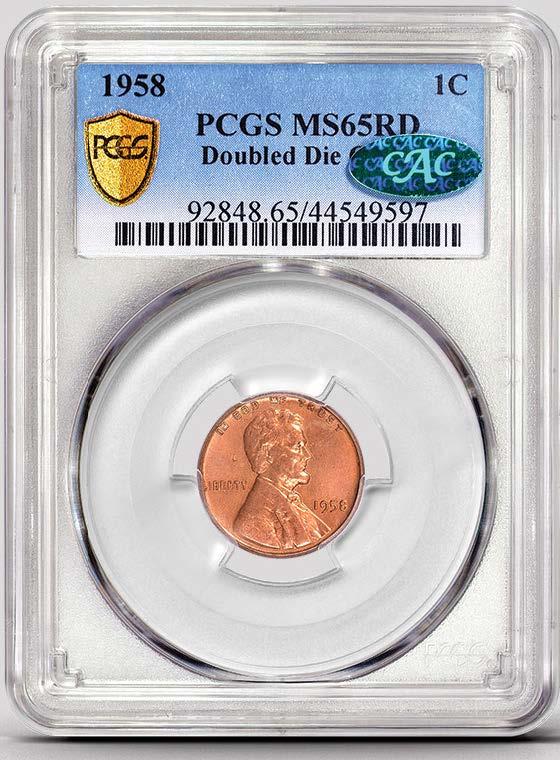
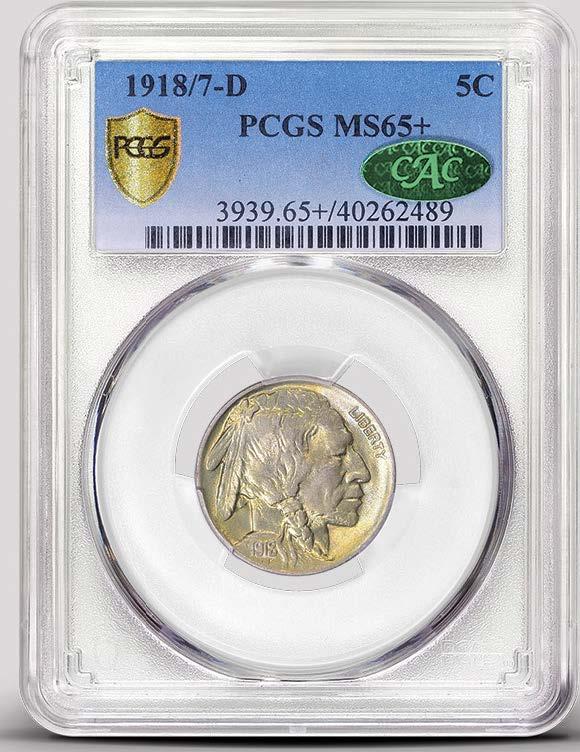

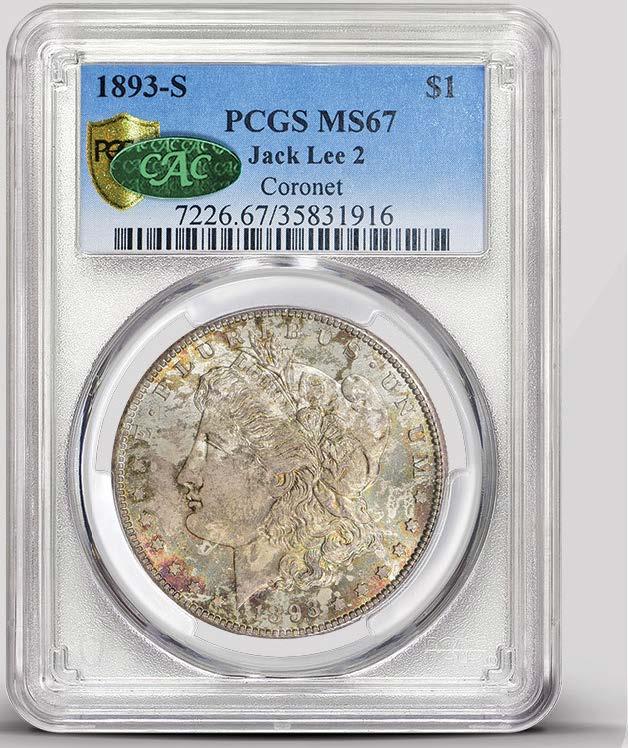
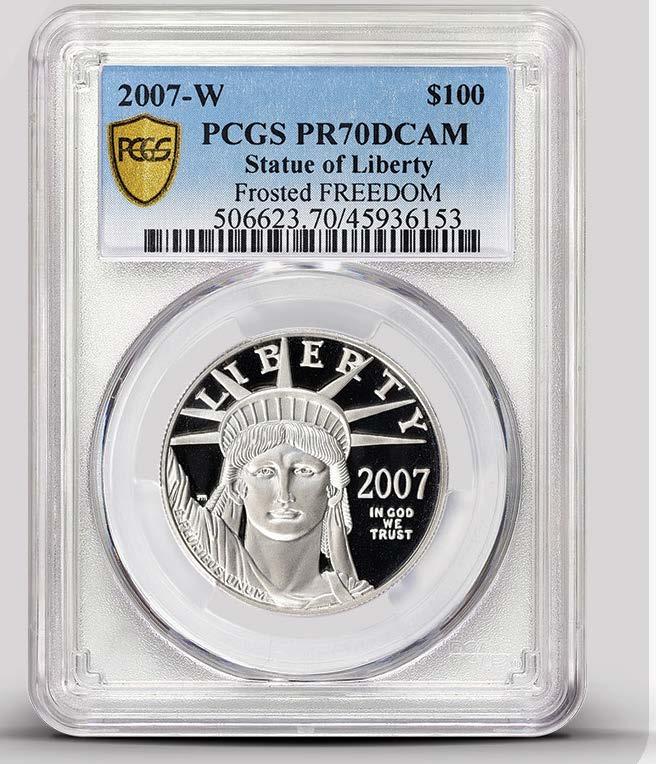

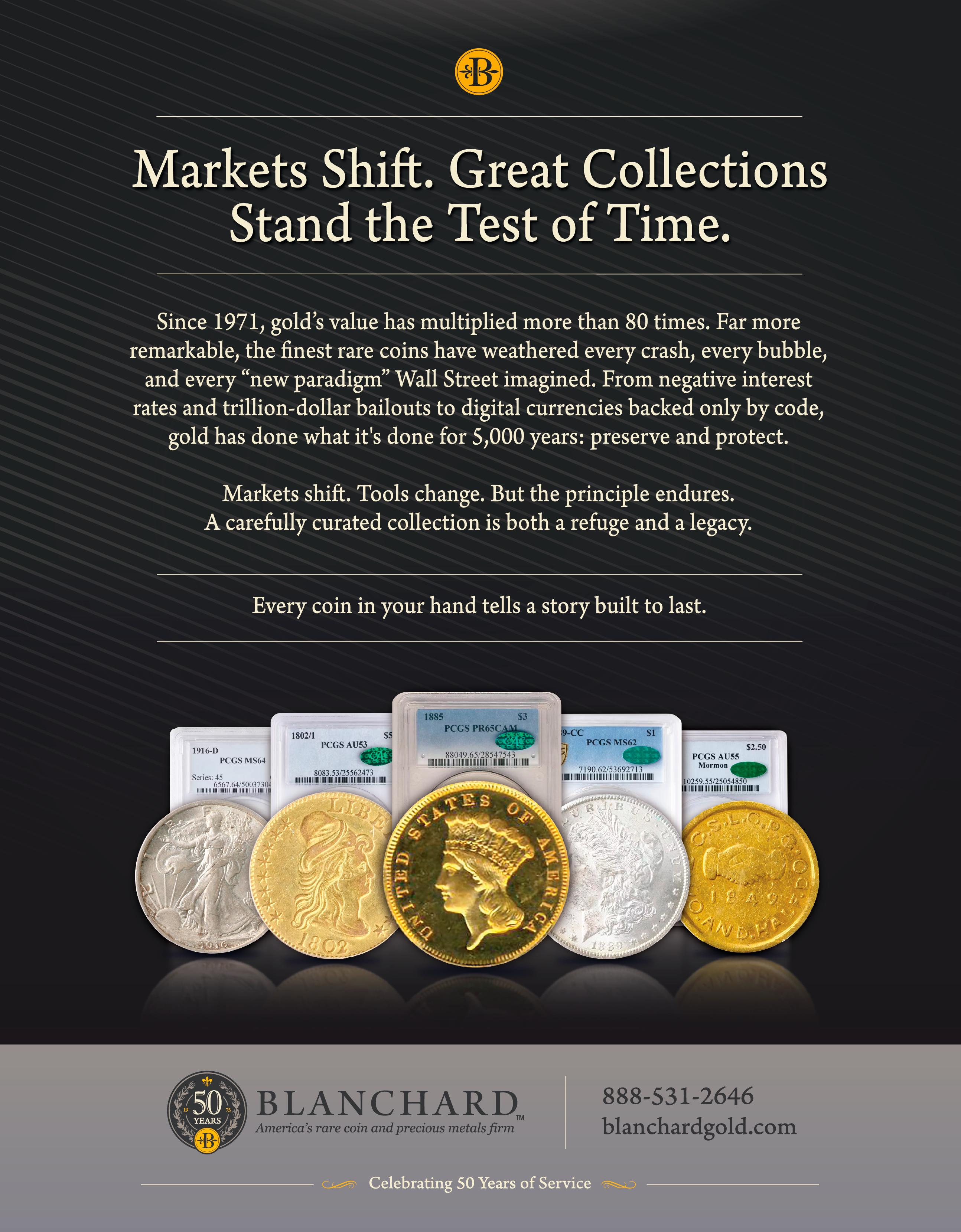
Featured Coin
Classic United States Silver Dollars
A Dream of Red Mansions
Mexican Silver Onza Libertad
Market 101
Rarities Up For Bids
Inside PCGS: Keith Dewald
Women on Money
Collector Highlight
Young Collector Profile
Varieties, Errors & More
Auction Action
PCGS Abroad Notable Notes
Life & Times of John Adams Bolen
By Joshua McMorrow-Hernandez
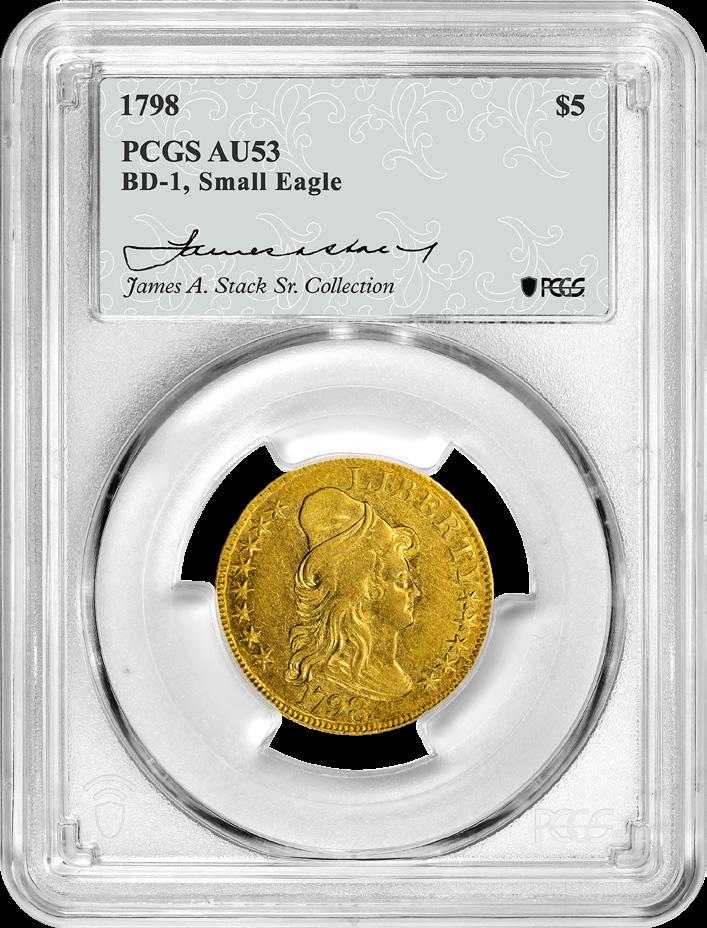

When news that coins from the prestigious James A. Stack, Sr. Collection were hitting the auction block once again, the numismatic world held its collective breath as it awaited details on the coins emerging for the first time in generations from this heralded cabinet. Connoisseurs knew this would be a special moment. After all, this was not the first time that coins from the James A. Stack, Sr. Collection had emerged into the marketplace.
The first coins from the magnificent collection of Stack were first offered by Stack’s Bowers Galleries’ predecessor entity Stack’s a half century ago, in 1975. These coins came onto the market nearly a quarter century after the collector, who had no familial relation to the auction firm or its founders, passed away in 1951. Stack had set out in the late 1930s to build one of the greatest United States coin collections of his time. And over the next many years, he did just that, acquiring multitudes of trophy rarities that brought the numismatic world to awe as they were ushered into the market during the 1970s, 1980s, and 1990s.
Now, as Stack’s Bowers Galleries prepares to hold the first of two auctions offering more than 200 coins from the James A. Stack, Sr. Collection, we explore one of the finest pieces from the cabinet. The 1798 Draped Bust Half Eagle with Small Eagle reverse is an exquisite rarity in every sense. This issue started off as a rarity in 1798 by the sheer fact that an unknown but very small number were struck. Today, only five are in private collections, all of which have been reviewed and graded by PCGS. An additional two are in the National Numismatic Collection at the Smithsonian Institution. Each of the known survivors has a colorful numismatic story, and the example that Stack’s Bowers Galleries offers has been in the custody of the James A. Stack, Sr. Collection for more than 75 years, purchased by Stack in the 1946 B. Max Mehl auction of the William Cutler Atwater Collection.
The example now being offered to the public for the first time in generations is graded PCGS AU53. Its quality is undeniable, as astute collector Stack chose only the best of the best available to him all those decades ago. The coin’s outstanding eye appeal and overall desirability are manifested with both CAC and CMQ stickers, which are bestowed only to specimens that represent premium quality for their type and grade. Though the PCGS AU55 Pogue specimen is graded finer, the Stack example has the best overall eye appeal of the three PCGS AU53-graded specimens –not unsurprising since the surfaces, strike, color, and overall appearance of the Stack example are such that it could garner the coveted CAC and CMQ nods.
many of the rarities is resetting the records on ‘finest-known’ specimens in several series.” Yegparian concludes, “Auction competition will be fierce!”
The last time a similar 1798 Draped Bust Half Eagle, Small Eagle came to market was the reappearance of the D. Brent Pogue specimen in the early 2025 offering of the Bruce S. Sherman Collection. Each time a specimen has crossed the auction block in the last decade, the increase in price realized has been significant. The Pogue coin achieved a recordshattering $1,175,000 in 2015, the Harry W. Bass specimen achieved $1,980,000 in 2023, while the Pogue coin rose to $3,000,000 in its early 2025 reappearance on the auction block. Once thought of as an esoteric rarity in the early gold series, the mystique and understanding of this coin’s story and overall rarity has only grown, ensuring that many paddles will rise high into the air once this coin crosses the auction block. The additional fact that the Stack name has long become synonymous with quality means that the numismatic world will be paying especially close attention to the sale of this specimen and others from its esteemed cabinet of origin.
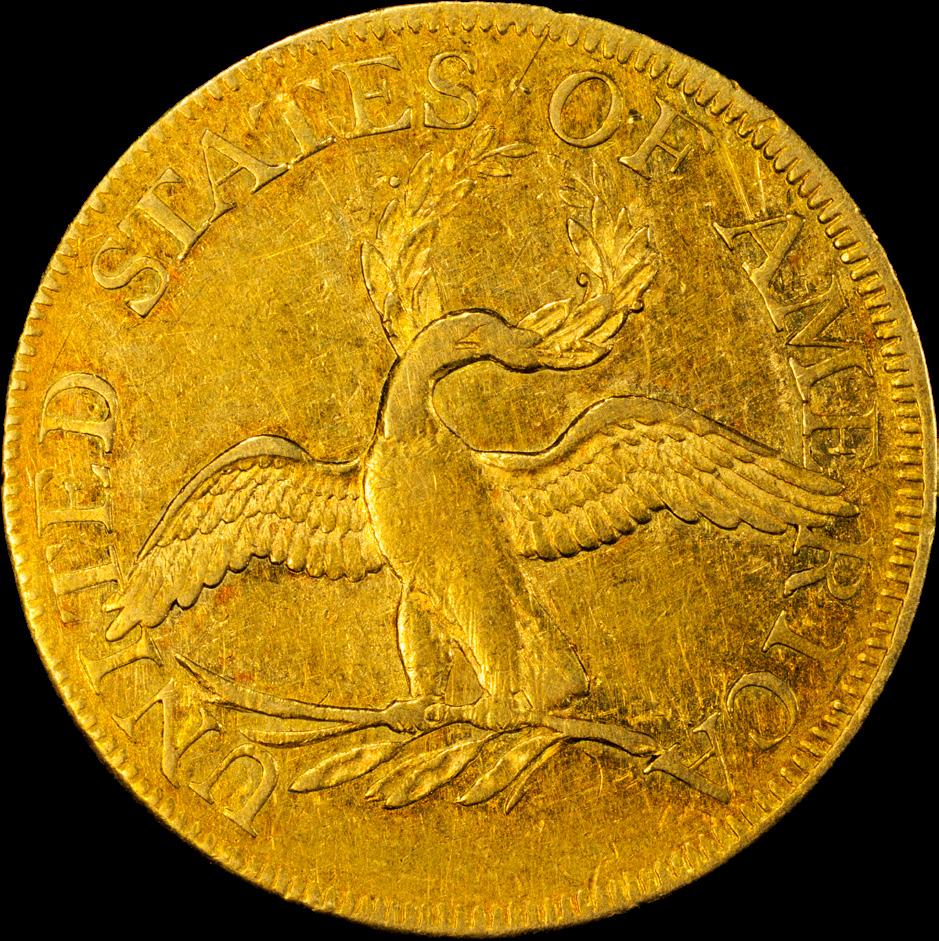
“The 1798 Draped Bust Half Eagle with Small Eagle reverse is the type of coin collectors dream about owning someday. When I first laid eyes on it, it was like finding buried treasure: this specimen had seemingly fallen off the face of the earth, leading some researchers to wrongly believe that it was the same as the new example discovered in 1996,” says Stack’s Bowers Galleries Executive Vice President Vicken Yegparian.
“Its inclusion in the James A. Stack, Sr. Collection really speaks to the magnificence and longevity of this cabinet,” he continues.
“Not only does the James A. Stack, Sr. Collection showcase an 1804 Draped Bust Dollar that had never been included in previous census information, but also the superb condition of
The coins now being offered from the James A. Stack, Sr. Collection range from early U.S. gold coins such as the 1798 Draped Bust Half Eagle, Small Eagle profiled here to silver rarities led by a newly published specimen of the 1804 Draped Bust Dollar, known as “The King of American Coins,” to the proof 1854 Large Date Liberty Head Double Eagle, the earliest date of proof double eagle confirmed in a private collection. The offerings are worth a cumulative $20 million, with many expected to individually hammer for more than $1 million apiece.
The James A. Stack, Sr. Collection will be offered in two spectacular events, the first being held on December 9, 2025, and the second on February 3, 2026. Both events will take place at the firm’s state-of-the-art Griffin Studios in Costa Mesa, California. For more information about the historic opportunity to own some of the greatest treasures the numismatic world has seen in years, please visit StacksBowers.com.

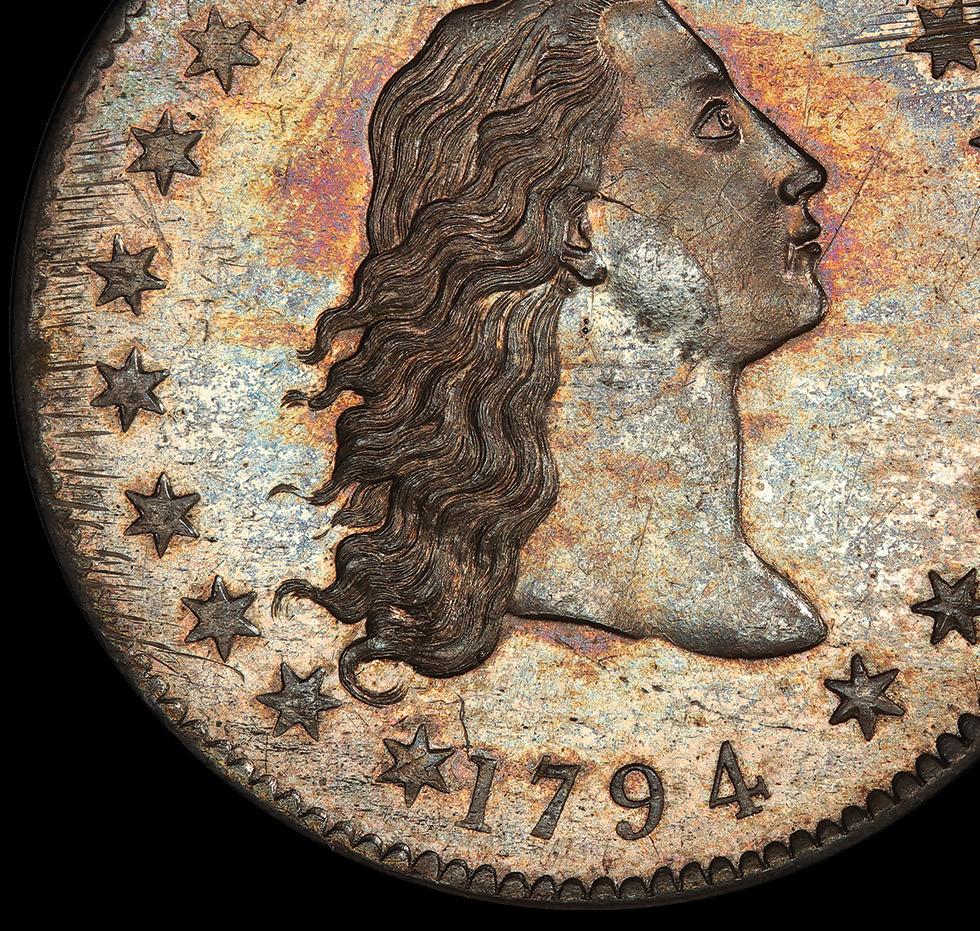

By Joshua McMorrow-Hernandez




The United States dollar has been the nation’s unit of currency since being authorized as such by the United States government in 1792. The dollar was modeled after the Spanish dollar or “pieces of eight,” which circulated widely throughout the colonies and served as an internationally accepted form of money for centuries. The dollar, which can be divided into 100 cents, has influenced not just the dynamics of the United States economy but has also served as a model of monetary systems around the world.
The first United States dollar was struck in 1794. While the iconic silver dollar was struck only intermittently over the next two centuries, the dollar remains an integral part of the nation’s economy. The dollar has manifested into a variety of forms, including base-metal coinage and commemorative coins, and this review will highlight the gamut of silver dollar coinage traditionally collected in type sets or date sets. They range from the early dollars of the fledgling federal era to the Morgan and Peace Dollars that represent two of the most widely collected coins in the American numismatic canon.
The first silver dollar ever struck bore the Flowing Hair design by Robert Scot and appeared in the mid-1790s. While the dollar had been authorized for production by the Mint Act of April 2, 1792, the first silver dollars were not struck until October 1794. Output was small for the first batch of Flowing Hair Dollars emerging from the young U.S. Mint. The Mint lacked the equipment for adequately striking coins larger in size than the half dollar. Therefore, a sizable quantity of 1794 Flowing Hair Dollars (perhaps 10% or more by some scholarly estimates) were deemed inadequate in strike and overall quality; these rejects were eventually repurposed.
All told, only 1,758 examples of the 1794 Flowing Hair Dollar were released by the United States Mint. Approximately 150 survive, and all are highly sought after as the ultimate first-year issue for the silver dollar. Most 1794 Dollars are known in circulated grades, and many of these are cleaned, holed, plugged, or otherwise exhibit some signs of damage or tampering. Any specimen is treasured by collectors, but those in problem-free condition are especially valued.
PCGS estimates that 10 examples remain in uncirculated grade, and at least one specimen strike took the numismatic world by storm in 2013. This example, graded PCGS SP66, was widely hypothesized to be the very first 1794 Flowing
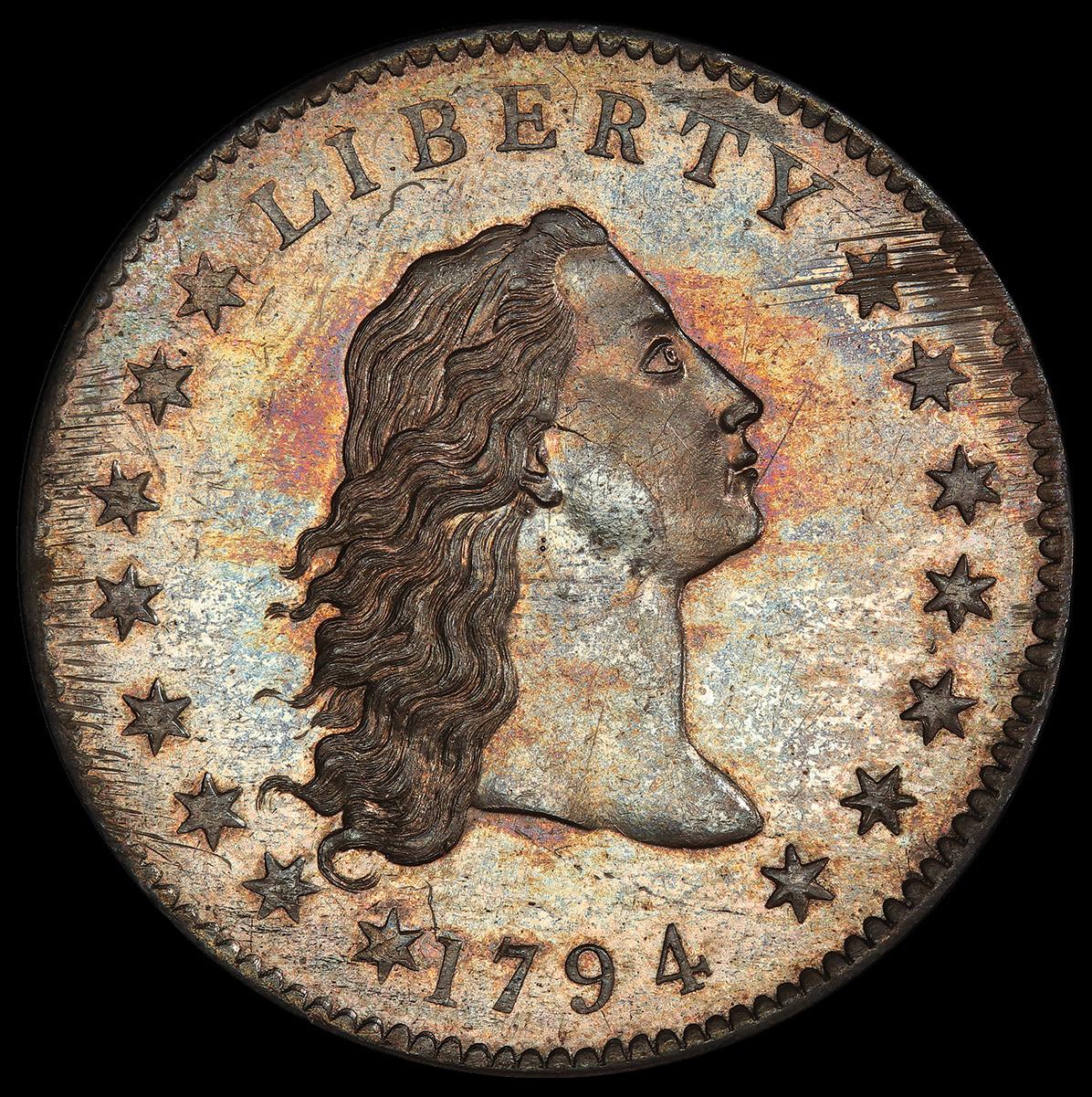
Hair Dollar struck. It is further thought (though unproven and unverified) that the specimen might have therefore been handled for initial inspection by United States Mint Director David Rittenhouse and possibly President George Washington, former Secretary of State Thomas Jefferson, and Secretary of the Treasury Alexander Hamilton. That famous 1794 specimen strike served as the world’s most valuable coin for years after it traded hands at a 2013 Stack’s Bowers Galleries auction for $10,016,875.
The Flowing Hair Dollar was also struck in 1795, when a respectable 160,295 were produced. While there are many more 1795 Flowing Hair Dollars in the marketplace than 1794 survivors, the incredible demand for 1795 Dollar is strong –especially from type collectors. Therefore, 1795 Flowing Hair Dollars see lofty prices.
Only a year after the Flowing Hair Dollar debuted, the type was replaced by the Draped Bust Dollar. Like its predecessor, the Draped Bust Dollar was designed by sculptor-engraver Robert Scot and features a portrait of Miss Liberty that is hypothesized to have been modeled after Philadelphia socialite Anne Willing Bingham. The Draped Bust portrait on the obverse of the dollar marked the first time this widely familiar motif was used on any United States coin. When the Draped Bust Dollar debuted in 1795, the reverse carried a Small Eagle design similar to that seen on the Flowing Hair Dollar. However, the Small Eagle reverse was replaced with a Heraldic Eagle design in 1798 and stuck with the Draped Bust Dollar for the remainder of the coin’s run.
When it comes to collecting Draped Bust Dollars, the plurality of those who purchase this popular coin do so for the purposes of completing a type set. However, there are many collectors who pursue date sets and even dedicate themselves to collecting the Draped Bust Dollar series by variety. Generally speaking, Draped Bust Dollars from 1795 through 1797 are extraordinarily rare, while the 1798, 1799, and 1800 are the most “common” in the context of overall availability as compared to other dates in the series. The 1801, 1802, and 1803 dates are quite scarce, though usually prices are similar to examples dated 1798-1800, grade by grade. Then there is the legendary 1804 Draped Bust Dollar.
Often dubbed “the king of American coins,” the 1804 Draped Bust Dollar reigns as a poster child of American numismatics and for good reason – only 16 specimens are known to exist. There are three different types of 1804 Draped Bust Dollars, and they’re categorized as Class I, Class II, and Class III. The Class I dollars, of which eight are known to exist, were struck around 1834 and produced as proofs to be included in special proof sets furnished to heads of state around the world as diplomatic gifts. The Class II and Class III 1804 Draped Bust Dollars are recognized as restrikes of the Class I 1804 Draped Bust Dollars, the most valuable of which is graded PCGS PR68 and sold for $7,680,000 in 2021. Examples of the Class II and Class III strikings came after 1857, with only one known Class II and seven of the Class III – the seventh Class III specimen was previously unpublished and was graded PCGS PR65 prior to its December 2025 offering in the James A. Stack, Sr. Collection by Stack’s Bowers Galleries.

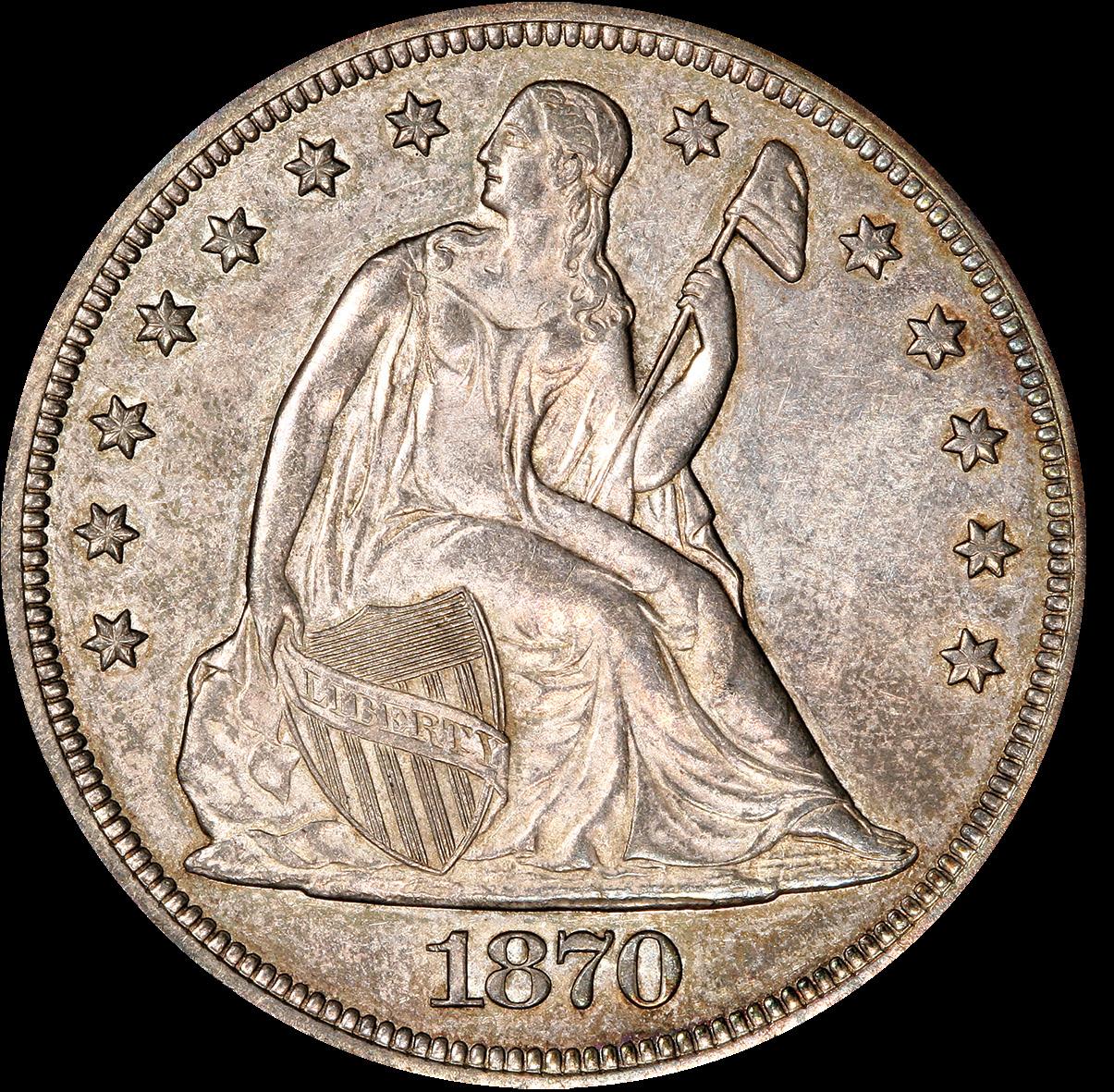
More than three decades after the last circulation-strike Draped Bust Dollars rolled off the presses, the United States Mint began laying the groundwork for the Liberty Seated Dollar. Designed by Chief Engraver of the United States Mint Christian Gobrecht, the Liberty Seated Dollar was first produced in the 1830s across a series of strikings largely regarded as patterns. After sporadic strikings in 1836, 1838, and 1839, the first large-scale production of Liberty Seated Dollars designed for use in circulation came in 1840.
The Liberty Seated Dollar series is subdivided into two subtypes based on the absence or presence of the motto “IN GOD WE TRUST.” The series originally came without the
motto, and these are aptly known as No Motto strikes. The motto was added in 1866, and this segment of the series is therefore classified as With Motto. The Coinage Act of 1873 demonetized silver, and this closed the books on the Liberty Seated Dollar that year.
Liberty Seated Dollars are categorically scarce regardless of grade, though there are many dates that are particularly rare. These include the 1851, 1852, and 1858 issues. Also scarce are the Carson City strikes of the 1870s. Then there is the 1870-S, which offers only a dozen known survivors. This famous rarity yields but one uncirculated specimen, which most recently garnered $1,092,500 when it was sold in a 2003 auction by the firm now known as Stack’s Bowers Galleries.
The Trade Dollar arose in 1873 at a time when the United States government sought to create a coin that could compete against other large-size coins circulating in international trade with Asia. The primary coin of choice for those involved was the Mexican 8 reales silver coins, which weighed 420 grains – 1.8% heavier than the standard United States silver dollar in production at the time. This compelled U.S. officials to devise a silver coin of similar specifications.
The result was the Trade Dollar, tipping the scales at 420 grains and chiefly designed as a coin for export as opposed to domestic use in the United States. As the Coinage Act of 1873 had demonetized silver in the United States, the Trade Dollar was patently created for use overseas.
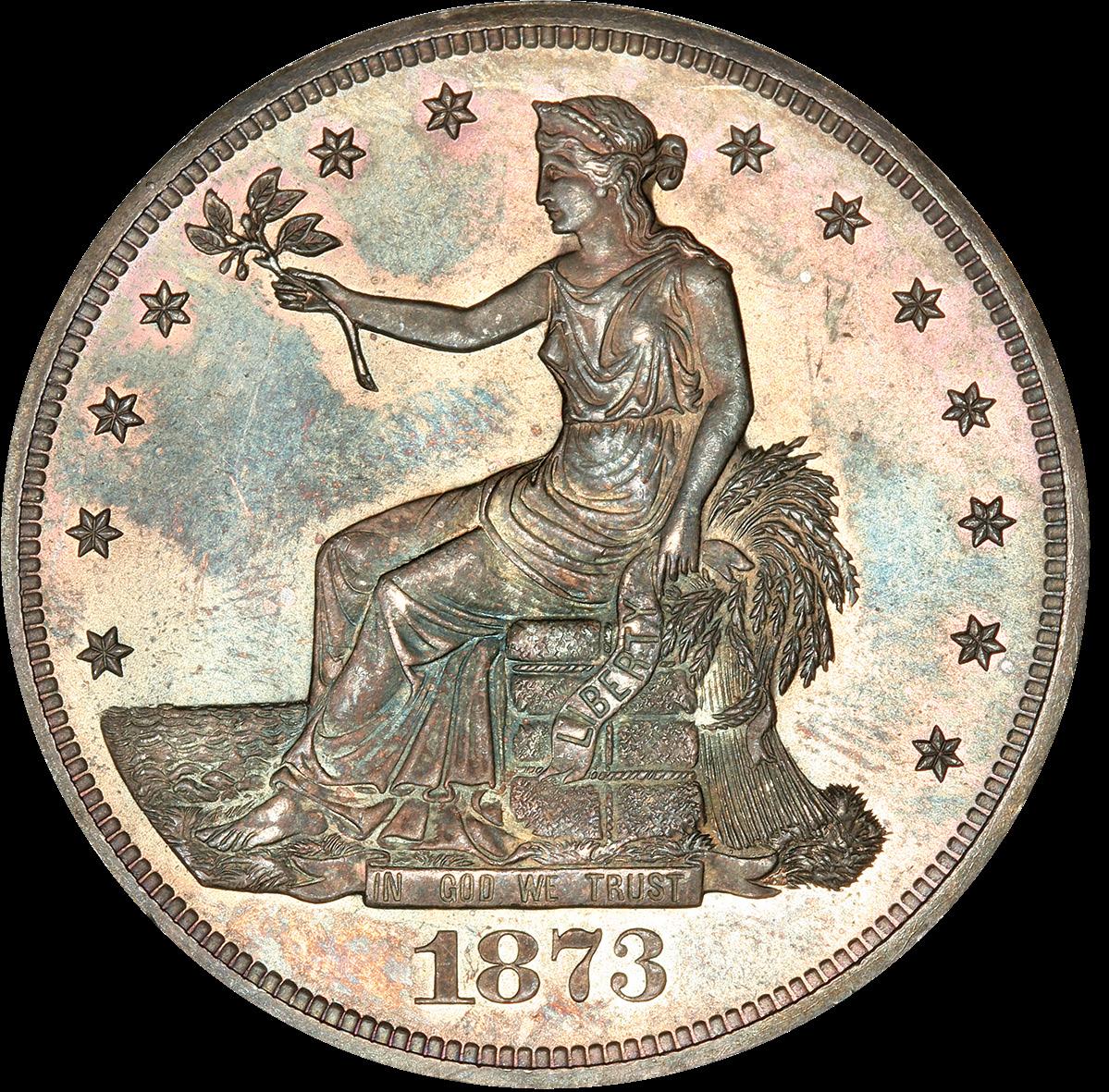
The coin saw limited legal-tender status in the United States, where it could be used in amounts up to $5. Meanwhile, the Trade Dollar made its way through Asia, where tens of millions of the coins filtered into commerce. It became somewhat customary for merchants accepting Trade Dollars to counterstamp them with markings known as “chops.”
The vast majority of Trade Dollars known today are circulated, though there are numerous uncirculated specimens for collectors. As vintage coin series go, some Trade Dollar issues are rarer than others. Trade Dollars from the Carson City Mint are categorically scarce. After circulation strikes came to an end for the series in 1878, the U.S. Mint continued producing proofs. A handful of proofs dated 1884 and 1885 are extremely rare and command astronomical prices. The 1884 proof is a six-figure coin, while the 1885 proof claims seven figures on the rare occasions it surfaces in public sales.
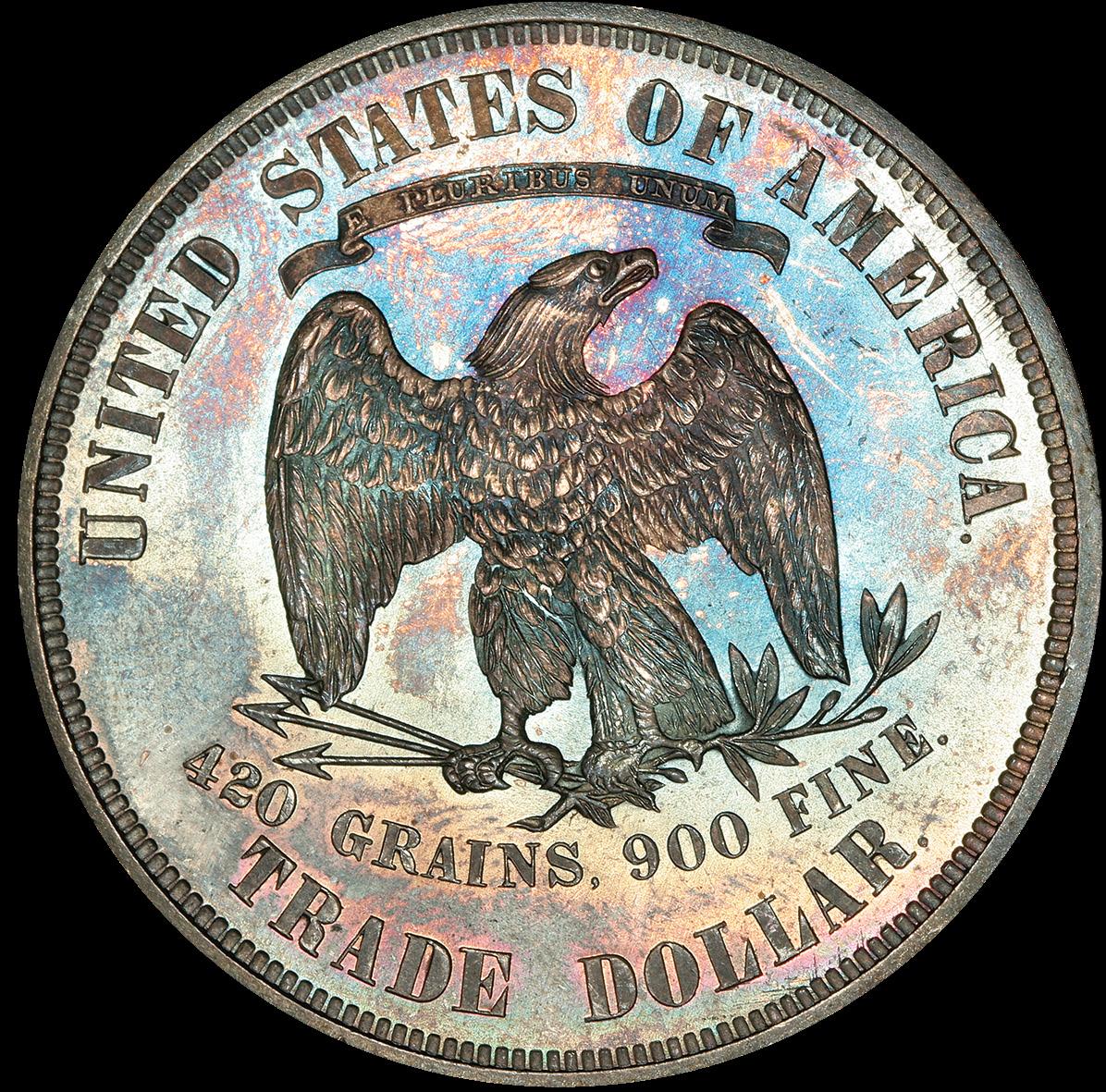
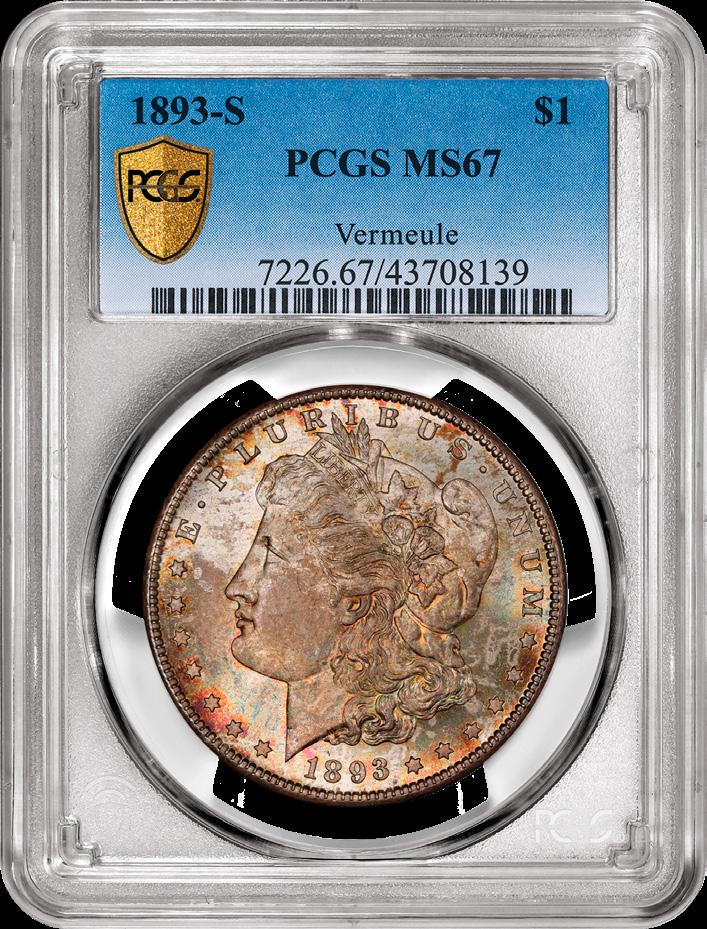
The Coinage Act of 1873 had demonetized silver, which was becoming more and more plentiful in the United States as western mines uncovered tons of the whitish-colored precious metal. As economic conditions worsened in the 1870s and as western mining interests gained more leverage in the halls of Congress, the Bland-Allison Act was passed in 1878. The law required the United States government to purchase silver at scale and convert the bullion into silver dollars. This resulted in the Morgan Dollar, which was first struck in 1878 and became one of the most popular collectible coins in the world.
The obverse carries a portrait of Miss Liberty, and the reverse features an ornate heraldic eagle. Both designs were the brainchildren of sculptor-engraver George T. Morgan, whose surname became the moniker for the coin. Morgan Dollars were struck at the mints in Philadelphia, Carson City, Denver, New Orleans, and San Francisco.
Most issues saw plentiful mintages, though there are many rarities known throughout the series. The most notable are the 1889-CC, 1893-S, and 1895 proof-only strike. All of the Carson City issues are also highly desired by collectors.
There is also the element of conditional rarity for most dates; these large, heavy silver coins were subject to multitudes of imperfections, such as deep scratches and contact marks when transported or stored in bag quantities. Some strikes produced prooflike fields and cameo (or frosted) devices, resulting in the PL (prooflike) and DMPL (deep mirror prooflike) grading designations that many collectors covet.
Morgan Dollars weren’t produced from 1905 through 1920, and a final emission in 1921 capped off the run for a series that arguably saw its most popular years after its production. These large silver coins saw heavy use in the Nevada casino circuit during the mid-20th century, and in the years that followed, several hoard discoveries cemented the coin’s allure in the public consciousness. The Morgan Dollar is also among the most widely collected coins by PCGS Set Registry Members, who have built more than 6,500 sets representing 40 different set categories – giving virtually every Morgan Dollar collector an exciting variety of set objectives tailored to their numismatic desires and budget.
World War I brought the United States into an alliance with many nations, including Great Britain, which was fighting a propaganda campaign by the Germans suggesting that British banknotes in India could not be redeemed for silver. This caused a major run on Britain’s silver reserves. In response, the United States stepped up to provide silver bullion to Great Britain and did so under the authority of the Pittman Act, which provided for the melting of up to 350 million silver dollars. Ultimately, more than 270 million silver dollars were converted to bullion and sold to the British at $1 per ounce. Compensating for the massive number of melted coins, the U.S. Mint resumed striking silver dollars in 1921; this explains why Morgan Dollars were rolling off the production lines again following a 15-year hiatus.
Immediately following the war, there were many calls to commemorate peace on American coinage. This culminated in 1920, when a paper written by numismatist Farran Zerbe titled “Commemorate the Peace with a Coin for Circulation” was read before attendees at the American Numismatic Association convention in Chicago. This led to the formation of a powerful committee that convinced lawmakers to consider the matter. However, as the Morgan Dollar design was already 43 years old, no Congressional action was necessary to introduce a silver dollar with a new “peace” theme; the Morgan Dollar was already much older than the 25 years that had to pass before a coin could be redesigned without Congressional approval.
A number of well-known sculptor-engravers, including coin designers Adolph Weinman and Victor D. Brenner, were invited to submit designs for the new coin. However, Anthony de Francisci won unanimous approval with his design, with an obverse depicting a young Miss Liberty crowned with rays (in a similar fashion to the appearance of the Statue of Liberty in New York) and a reverse anchored by an eagle. Following minor changes to the designs as originally submitted by de Francisci, the first Peace Dollars were struck in the waning days of December 1921.
The Peace Dollar series continued until 1928, when the last coins struck under the provision of the Pittman Act were produced. Another Congressional act in 1934 instigated the production of more Peace Dollars in 1934 and 1935, though the lack of demand during the economic malaise of the Great Depression preempted further production. A limited run of
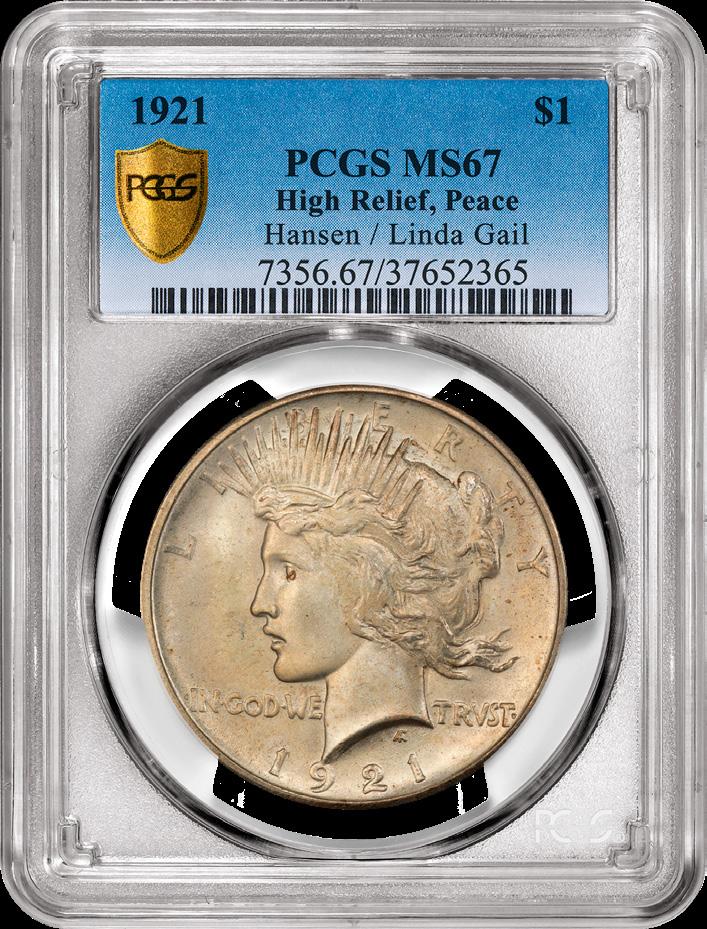
1964-D trial strikes was produced at the Denver Mint in 1965, though all were reportedly melted and none are known to survive; even those that did would be illegal to own since the coin was ordered for melting and never officially deemed legal tender.
The relatively short run of the Peace Dollar makes this series easier for some to collect, though there are some keys and semi-keys. Among the notables are the 1921 with its high-relief strike and mintage of just over 1 million, the 1928 Philadelphia strike (with its claim as the lowest-mintage circulation strike at 360,649 pieces), and the 1934-S – a coin that wasn’t saved in large quantities and is now very scarce in better grades. A handful of special 1921 and 1922 Peace Dollar strikings, some in high relief and others in low relief, showcase matte and satin finishes not seen on regular-production Peace Dollars and are highly rare and valuable.
In 2021, the U.S. Mint recognized the centennial of the last Morgan Dollars and first Peace Dollars with new silver dollars bearing both vintage designs and the current date. These contemporary Morgan and Peace Dollars are still being struck in various finishes and now constitute a new genre of silver dollars for collectors to enjoy.
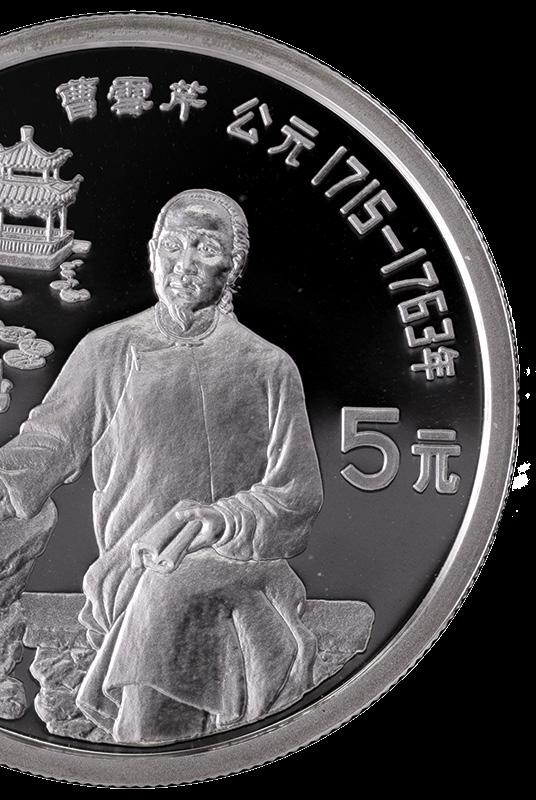
By Peter Anthony

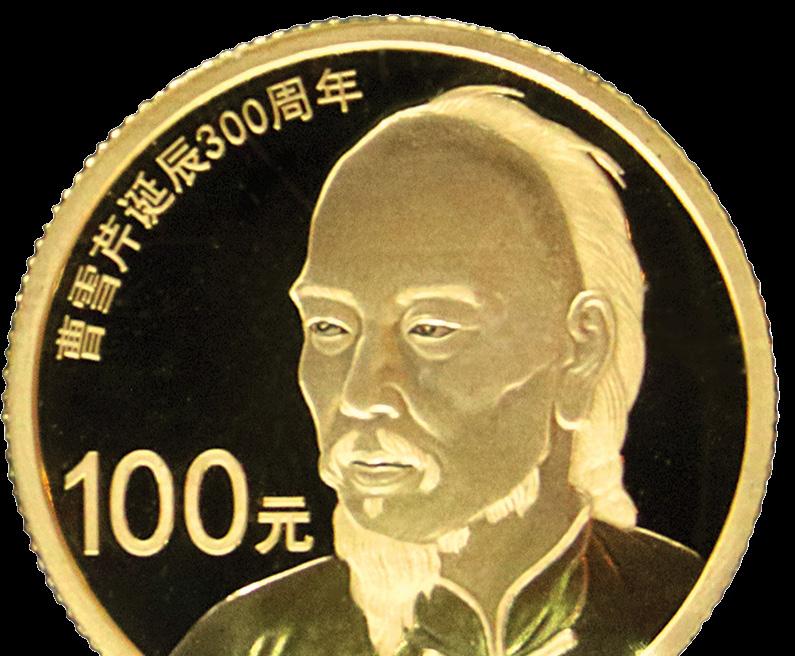

The showcase at the American Numismatic Association World’s Fair of Money in Oklahoma City is filled with money from around the world, including old coins from China. One coin in particular stood out due to its condition. An auctioneer’s label on it described the coin as VF, but it shows no apparent wear on its surfaces.
“It was passed on at auction, so I took it back, and you can buy it for less than the reserve was,” the coin dealer tells me.
It’s a Qing Dynasty 10 cash coin from the time of Emperor Xian Feng in the mid-1800s. His decade of rule is notable for several reasons, among them the inflation that resulted in 5 cash coins being melted down and being recast as 10 cash coins. Behind that problem was the Taiping Rebellion that deprived the imperial treasury of revenues from the rebel areas.
Secondly, the emperor conceived a son with a concubine, named Cixi. When the child was six years old, he assumed the throne in 1861 upon the death of his father. Cixi deftly maneuvered to eventually become the effective ruler of China until her death in 1908.
All this history was implied in the beautiful coin before me. I bought it.
The history of China often involves wars for domination between southern and northern groups. When the Song Dynasty capital in Bianjing fell in 1115 A.D., much of the northern part of the country came under the rule of the Great Jin (or gold) Dynasty, a group originally from Outer Manchuria. A little more than a century later, the Great Jin fell to Mongolian invaders who established the Yuan Dynasty. The Mongols swept through all of China, and their rule continued until 1368, when southern-based groups defeated them to
establish the Ming Dynasty.
The Ming Dynasty lasted until 1644 when, through complex circumstances, it was replaced by peoples related to the Great Jin Dynasty. These took on the name of the Qing Dynasty. Their second emperor, Xuanye, was born in 1654. With his story, the roots of one of China’s greatest works of literature were set down. As a child, Xuanye was cared for by a wet nurse who had a son of her own about the same age as the royal child. His name was Cao Yin, and he and the future emperor became playmates and friends.
When Xuanye was just seven years old, his father died, and the young boy assumed the throne. He became known as the Kangxi Emperor. For the next 61 years, he would rule China. The emperor and Cao Yin remained friends, and Cao Yin proved to be quite talented as both an expert horseman and as a poet, both traits much admired in the Qing court. Cao Yin benefited from this connection in many ways. In time, the emperor appointed him as the commissioner of imperial textiles.
Ci (pronounced like “shhh”) poetry is a style of lyric poetry that mixes aspects of classical Chinese poetry with folk traditions. It was favored by some of China’s greatest poets during the Song Dynasty, including poet Li Qingzhao. In 1705, the emperor decided that a complete compilation of Ci poetry was needed. Cao Yin (Cao is pronounced like a “sow”) was placed in charge of the project and sent to the old Southern Song capital city of Nanjing.
Despite the wealth and prestige that he achieved, Cao Yin understood that his success depended on the whims and health of one man. Someday it could shatter like a fallen vase. He told his family, “When the tree falls, the monkeys will scatter.” Things were still good for the family when Cao Yin’s grandson, Cao Xueqin, was born around 1715. Attended by hundreds of servants, the boy was brought up in luxury.
The monkeys scattered in 1727. The Kangxi Emperor passed away and was replaced by his 11th son, the Yongzheng Emperor. The new emperor did not approve of the Cao family. Troops seized all their worldly possessions, and their servants were detained for questioning. The now-penniless family fled Nanjing for Beijing. The events must have profoundly shocked the 13-year-old Xueqin, who was suddenly forced to learn to survive on the streets of the capital city.
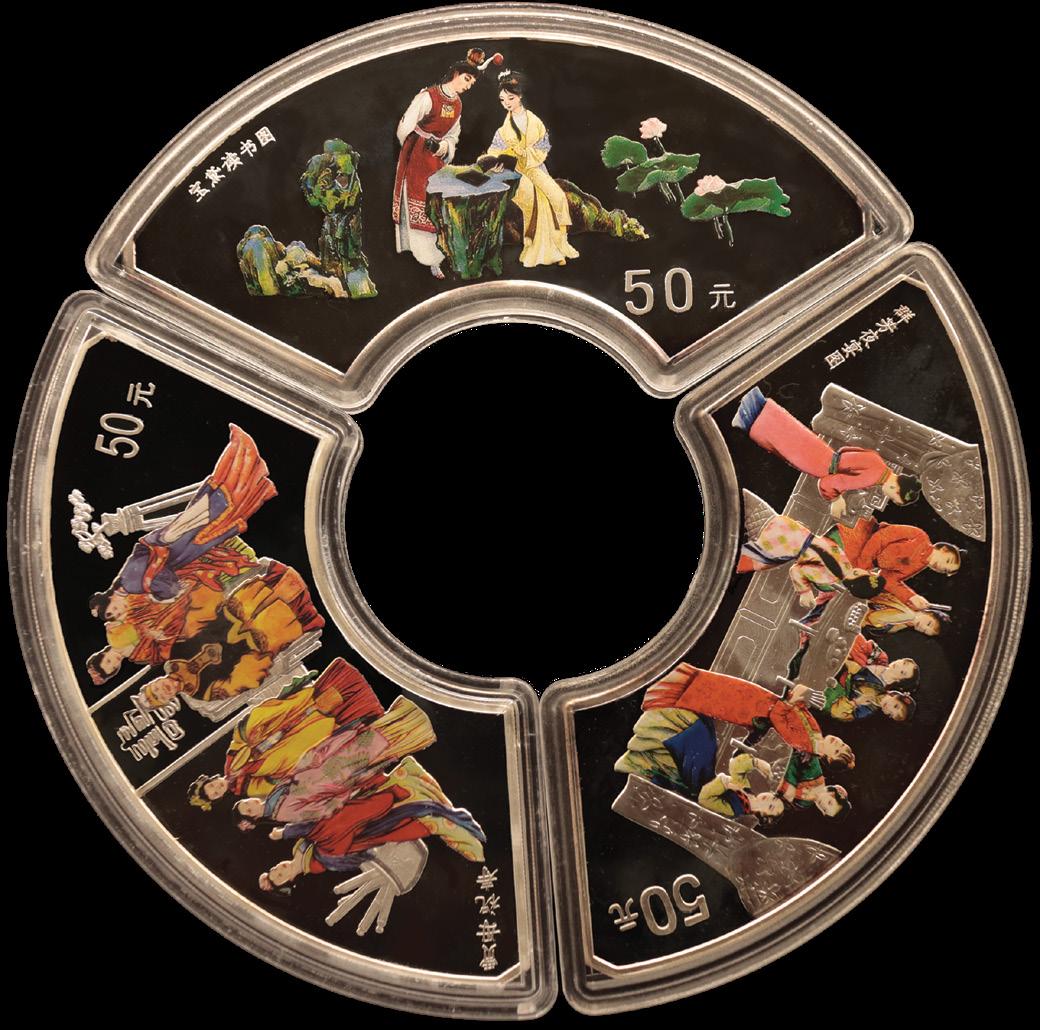
Although no samples survive, Cao Xueqin must have been talented with a brush as well as with words. He developed a clientele for his artwork and calligraphy. Although his current status in life was low, his gift for language gained him entry to literary circles. There, his early education and understanding of the social graces created opportunities to find work as a tutor to the children of wealthy families. Unfortunately, this source of income ended due to a scandal with a woman servant. This was part of a lifelong pattern; Cao Xueqin never succeeded in finding a good job. Instead, he wrote a novel in bits and pieces, one chapter at a time, called The Dream of Red Mansions, or Dream of the Red Chamber
Some authors write tales of adventures and quests. Others find gripping drama beneath the surface of a quiet day. Cao Xueqin’s was inspired to vividly describe scenes of Qing Dynasty life that he recalled from his youth, like this passage about a garden party, “It is about this time that the blossom begins to fall; and tradition has it that the flower-spirits, their work now completed, go away on this day and do not return until the following year […] Soon every plant and tree was decorated […] Moving about in the midst of it all, the girls in their brilliant summer dresses, beside which the most vivid hues of plant and plumage became faint with envy, added the final touch of brightness to a scene of indescribable gaiety and color.”
The writer basically invented the modern Chinese novel out of necessity. For all his personal disasters, he eventually found a refuge – a spartan cottage on the outskirts of Beijing. Arranged by a family friend, it was far from the central city. “The reminders of my poverty are all around me,” he despaired. In this semi-seclusion, Cao Xueqin could reflect on life, and there, out of contemplation and need, an idea for a grand story was born.
Like any good serial, his tale kept readers in suspense as they longed to read the next chapter. Cao Xueqin traded peeks at his new manuscript for food, drink, or perhaps coins. Over time, he would fully set down on paper 80 chapters and, although there’s some controversy about this, notes for 40 more.
The writer dedicated the book to the women he had known, “In this busy, dusty world, having accomplished nothing, I suddenly recalled all the girls I had known, considering each in turn, and it dawned on me that all of them surpassed me in behavior and understanding... But no matter how unforgivable my crimes, I must not let all the lovely girls I have known pass into oblivion without a memorial.”
The book title itself, A Dream of Red Mansions, comes from a set of fairy songs. In it, Cao writes about a boy named Jia Baoyu who is born into a noble family. Inside the infant’s mouth rests a mystical piece of jade. Years later, the fairy songs in the title come to Jia Baoyu in a dream. He never realizes that they foreshadow the fates of all those he cares about. The Goddess of Disenchantment watches and laments, “Silly boy, you still don’t understand.”
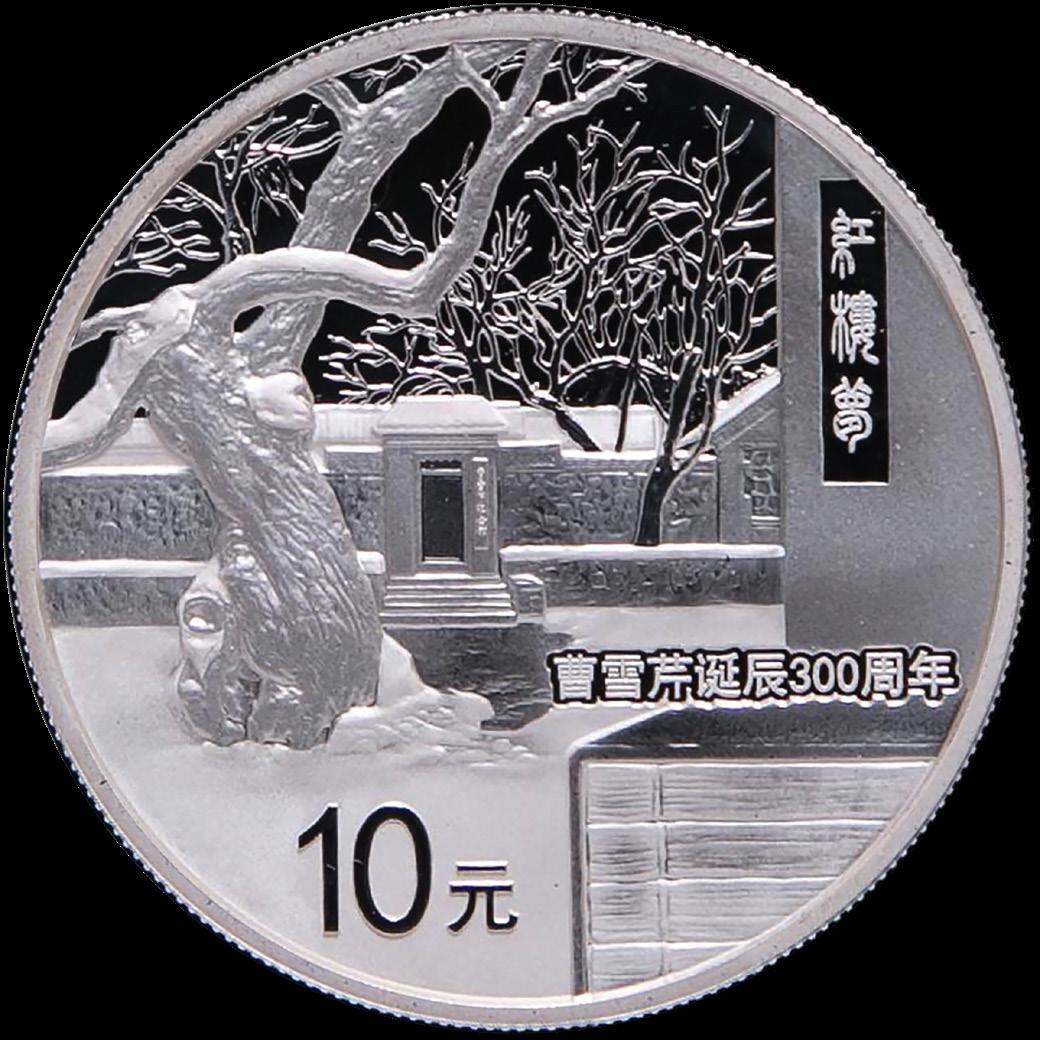
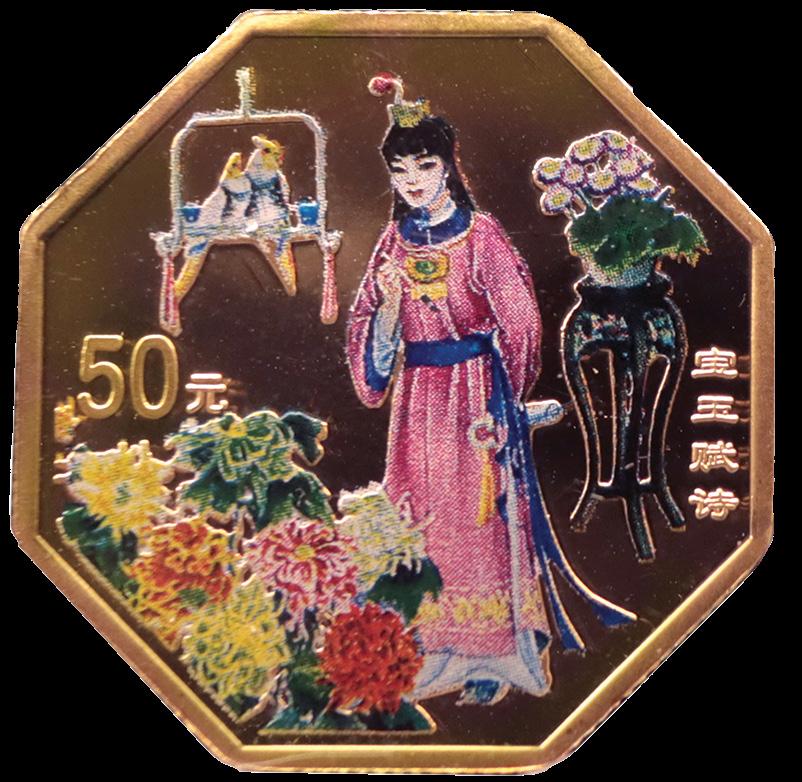


Jia Baoyu grows up as the sensitive son of a fiercely demanding father. The boy is gifted in the arts, but uninterested in the scholastic skills that society prizes — like an apathetic child whose dad is determined to raise a star athlete. Neither father nor son can ever accept one another for who they are. Is this Cao Xueqin himself?
Another main character is Lin Daiyu. She is a flower that Jia Baoyu waters and magically comes to life to repay her “debt of tears.” Baoyu and Daiyu are the book’s only characters with a mystical connection. Beautiful, well-educated, and prone to melancholy, the blossoming of her relationship with Baoyu, children who grew up side-by-side, is a central part of the novel’s plot. Their tale captures all the excruciating awkwardness of adolescence. Who does not know this pain? “In fact, to start with, their two hearts were one, but each of them was so hyper-sensitive that their longing to be close ended in estrangement.”
The third character in a love triangle is Xue Baochai. Extremely beautiful, socially graceful, and always composed, she is what Lin Daiyu is not. The marriage of Jia Baoyu and Xue Baochai is tragic because Baoyu can never forget Daiyu.
In all, A Dream of Red Mansions introduces more than 400 characters whose lives and fortunes cross. In the end, as predicted, the fortunes of the noble house dim. Lin Daiyu dies of a broken heart as Jia Baoyu is tricked by his family into marrying Xue Baochai. Baoyu can never forget his lost love and ultimately vanishes from this world, just as Cao Xueqin did after writing this book.
Two centuries after the publication of A Dream of Red Mansions, we are left with China’s greatest novel and a mystery. How, in his circumstances, did Cao Xueqin produce this masterpiece?
“You can know a man’s face but not his heart,” Baoyu’s friend Xifeng muses. Pushed to his limit, Cao Xueqin shows us his heart. A teacher once told me that when a tree is dying, it will bloom magnificently one last time before it goes. A Dream of Red Mansions is the final bloom of genius that still glows today with passion from time immemorial.
For numismatic fans, images of some of the more important personalities can be found on a series of colored coins that China released in 2000, 2002, and 2003. For each year a halfounce .999-fine gold coin, a 5-ounce .999-fine silver coin, and four 1-ounce .999-fine silver coins were released. All coins display a representation of the author, Cao Xueqin, on the obverse together with the date of the coin. The three 5-ounce silver coins released are shaped like fans, and a full set forms a circle. All three years of gold are octagonal in shape and have a circular diameter of 27 millimeters. The engraving on the reverse faces is credited to PAMP, Switzerland. The 1-ounce silver coins are octagons, too.
The 2000 50 Yuan coin’s reverse portrays Baoyu Writing a Poem. Its mintage is 8,800. There is no coin for 2001, but the 2002 half-ounce gold coin has a denomination of 200 yuan and a mintage of 8,000. The reverse of this coin features an image of Xiangyun Sleeping Drunkenly on it. The 2003 200 yuan gold coin reverse displays Daiyu Winning the First Prize. Its mintage is also 8,000.
Although Cao Xueqin did not live to see his masterpiece published, A Dream of Red Mansions remains among the most popular Chinese novels 250 years after it was authored. The numismatic tributes to the author are a testament to greatness.
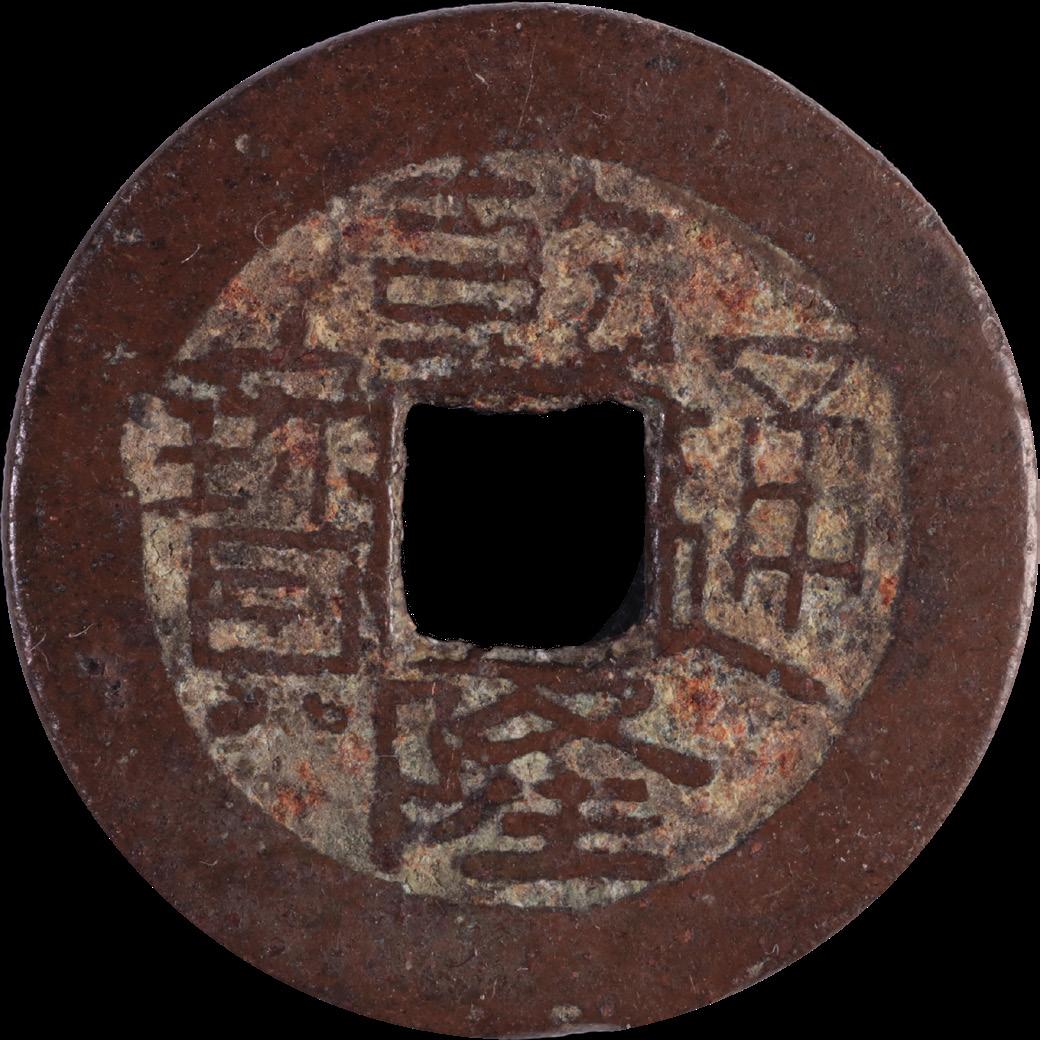
By Sanjay C. Gandhi
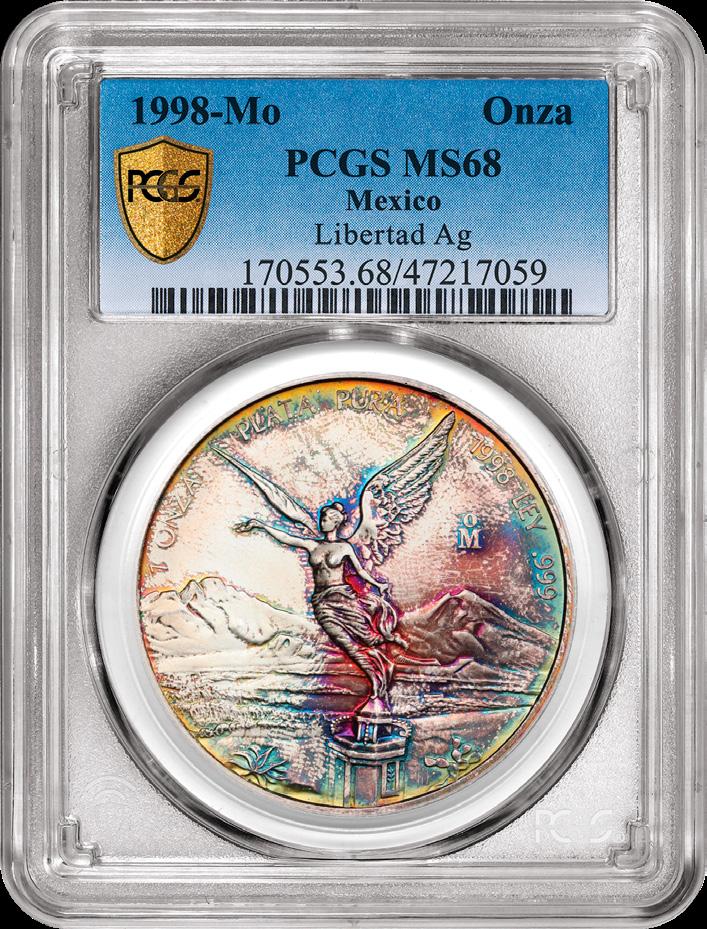
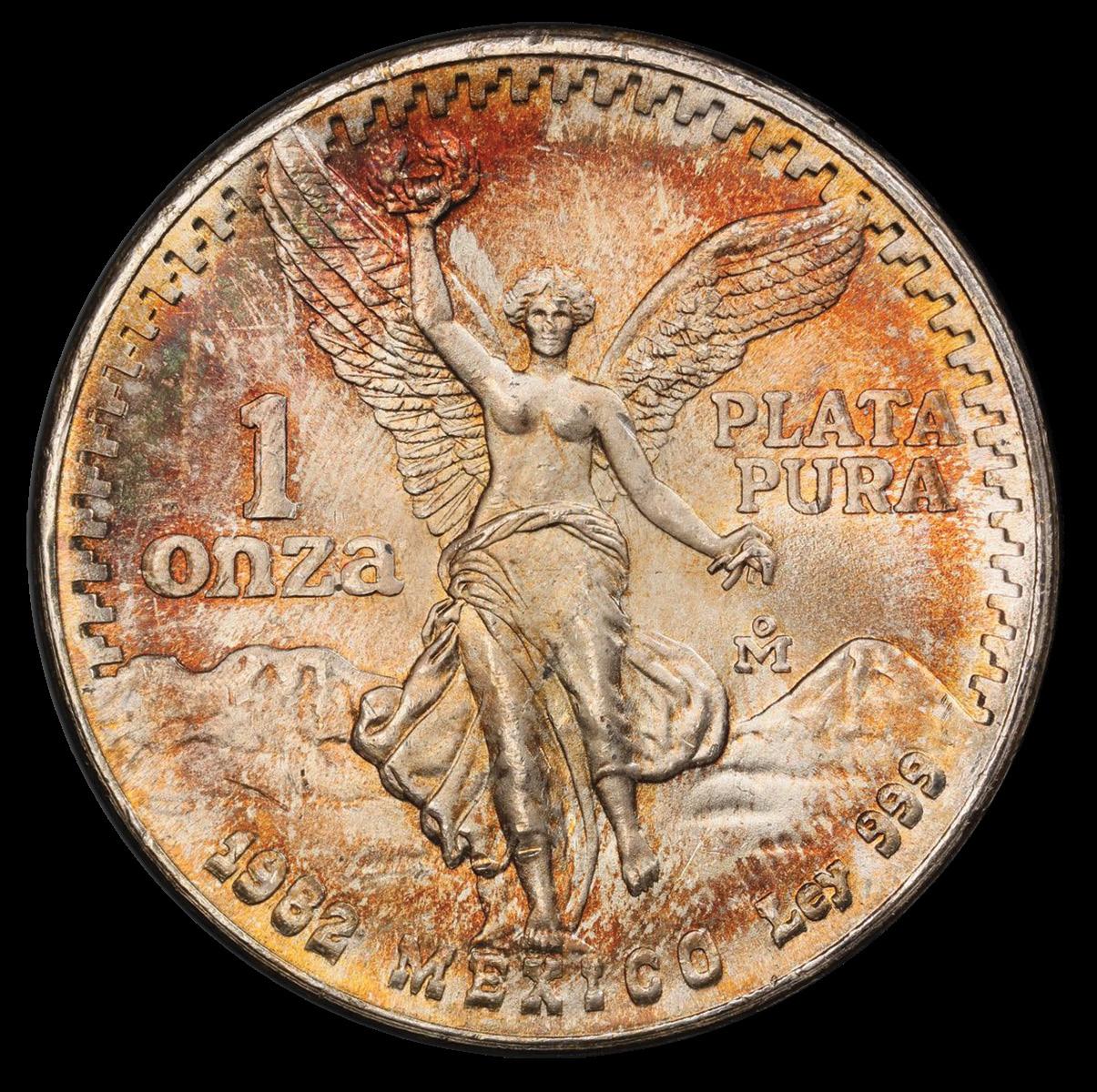
In the previous issue of PCGS Insider, we highlighted the Onza Troy struck by the Banco de México. The 1949 Onza Troy was the first one-ounce silver bullion coin to be issued by a government. The coin took a hiatus for a while, and production resumed from 1978 through 1980.
On January 19, 1980, the price of one troy ounce of silver reached a record-closing price of $49.45 because two brothers named Nelson Hunt and William Hunt manipulated the silver futures markets; the duo was infamously known as “the Hunt Brothers.” By the end of December 1981, the price of silver had hit the price of $8.48, which means it had lost over 82% of its value from its pinnacle less than two years earlier. The peak of the silver bubble in 1980 left many collectors, investors, and speculators scratching their heads. Banco de México elected not to issue the Onza Troy for 1981.
In 1982, Banco de México redesigned the bullion coin, and the obverse introduced the Angel of Independence. Two volcanoes, Popocatépetl and Iztaccíhuatl, are proverbial twins flanking Lady Liberty. This design is derived from a famous landmark called the “Monument of Independence” located in Mexico City, Mexico, and is also known locally as El Ángel. The landmark was commissioned to be constructed by the president of Mexico, Porfirio Díaz. Architect Antonio Rivas Mercado was in charge of the project, which began in 1902; the monument was completed in 1910 to commemorate the centennial of the beginning of Mexico’s War of Independence. The reverse of this newly issued bullion coin depicts the “Eagle with Snake” in its beak and the bottom half of the snake held with its talons, which is a classic design among Mexican coinage and is an image featured on the Mexican flag.
The Onza Troy was no more. The Onza Libertad became the new one-ounce bullion coin.
The 1982 Onza Libertad was struck at the mint in Mexico City, Mexico, and these coins were issued in rolls of 20 coins each. Rolls of the Onza Libertad can be found on eBay, with lots carrying the common dates selling between $1,100 to $1,300 per roll. These coins were packaged in metallic-looking cardboard rolls stacked on top of each other, and one side is about 90% exposed to the elements. On that end of the roll, the coin may randomly tone marvelous colors, and collectors frequently pay up handsomely for these examples. The other side is covered with two strips of metallic silver tape, with the words in blue stating “Banco de México 20 ONZAS DE PLATA DE .999.”
Silver bullion is soft, as it is almost 100% pure. It’s therefore prone to a buffet of problems, such as nicks on the highpoints, and whatever your wandering mind may imagine, which could bruise your precious collectibles. What this translates
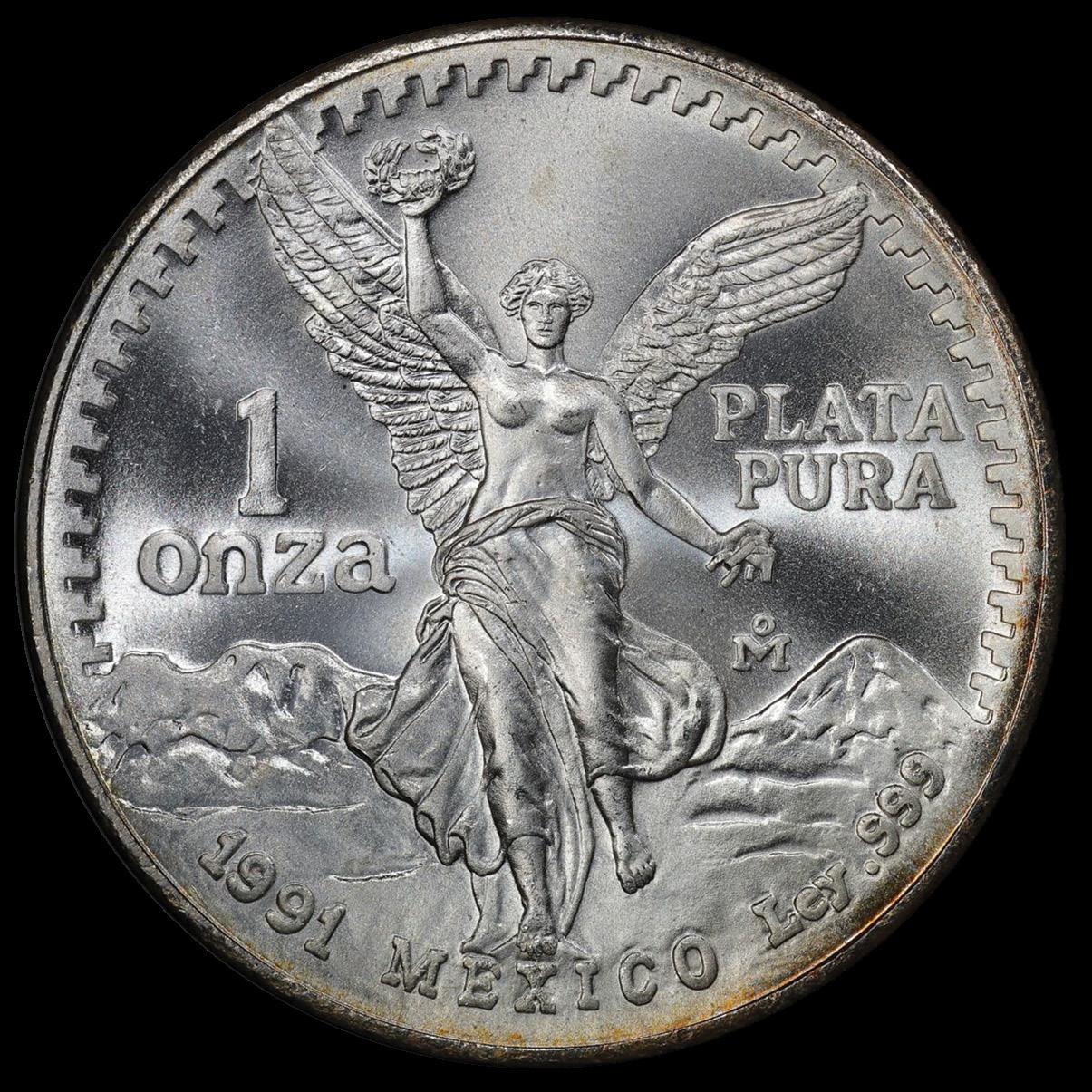
into for collectors of coins in MS70 grades is that no such numismatically “perfect” example exists for the first nine years of this series. MS69 is the highest grade to be scored from that period of this series – if you are fortunate to even score one at all.
If you choose to bid in an auction on eBay for an MS69, where a majority of transactions take place for Onza Libertads, be prepared to pay up, as many will fight you until the end, given the competitive nature of the market. From 1982 through 1986, some 1 million to 2 million Onza Libertads were produced, and the most condition-sensitive date is 1982, which will cost about $1,000 in a grade of PCGS MS68. A variety known as the 1982 DDO (Doubled Die Obverse) could cost $2,000 or more if you’re seeking an MS68 example. Buying the remaining dates in PCGS MS68 will cost Onza Libertad collectors anywhere between $200 and $400 per coin.

The 1987 Onza Libertad, in comparison to the previous years, has a relatively low mintage of 500,000 coins. This year also has a variety known as the 1987-Mo Doubled Die Obverse, which can set collectors back about $200 in a PCGS MS66 grade. The 1988 issue is also known for a DDO variety that is slightly scarcer than 1987 and would cost about $300 in PCGS MS66. For the years 1989 and 1990, collectors can expect to pay between $150 to $200 for a PCGS MS66 example.
In 1991, two types of Onza Libertads were struck: Type 1 Onza (mintage 1.1 million), and Type 2 Onza (mintage included in the Type 1 mintage). The Banco de México struck the 1991 Type 1 “Onza” Libertad, and during the year they planned to release a five-coin set with fractional coinage and a design change on both sides. This five-coin set included a one-ounce, ½-ounce, ¼-ounce, 1/10-ounce, and 1/20th-ounce coin. Only 50,000 sets were issued, and the word “OnZa” is spelled just as you can see from the picture, with a capital and lowercase letter rotated. On the TYPE 1, “ONZA” is capitalized as illustrated, and the design is more compact in general.
Accounts vary online about the Type 2 OnZa Libertad mintage, but savvy collectors have been aware of this low mintage for many years. The PCGS population report also confirms that the coin is not easy to find in general, and there may be 50,000 coins or less. Since the beginning of 2025, the 1991 Type 2 has witnessed a sharp price increase, and a PCGS MS69 will more than likely cost collectors a cool $3,000 nowadays. Collectors have recognized that the 1991 Type 2 coin is scarcer to find than the famed 1998 Onza Libertad issue. The proverbial cat has moderately been climbing out of the bag over the years, and it is now running.
From the date range of coins from 1992 through 1995, the most sought-after years are 1994 (mintage 400,000), then 1995 (mintage 500,000), 1992 (mintage 2.4 million), and 1993 (1 million) being the most common of these dates in terms of condition. The design change in 1991 made MS70 grades difficult to acquire, as the highpoints are prone to friction. The only date where a collector may find a PCGS MS70 is the 1993 issue, and there is one MS70 graded for 1992.
In 1996, Banco de México made another reverse design change; the Angel of Independence design is smaller, but the design now includes part of the column, and the diameter of the coin also became wider. The coins of this design have a better chance of scoring an MS70 than the previous designs, as the highpoints are not as high. Our 1996 (mintage 300,000) and 1997 (mintage 100,000) Onza Libertads are semi-key years and could cost a collector about $650 for a PCGS MS69 specimen.
The 1998 issue is the series key with a mintage of only 67,000 coins. This date has been sought after by collectors for many years, and an MS69 example can cost a collector about $2,500; an MS70 can fetch some $6,000! A variety exists for the 1998 Onza Libertad, which is called the “Die Chip on Eagles Head.” This coin trades at about a 50% premium, and a PCGS MS69 can cost north of $4,000 today. The 1999 Onza Libertad (mintage 95,000) is a semi-key date as well, and an example can be purchased in a PCGS MS69 grade for about $800 to $900. Collectors who would like to assemble a set sans varieties may consider building the Mexican Onza Libertad Silver, Circulation Strikes (1982-present).
In 1999, Banco de México started planning an obverse (eagle side) design change for the 2000 Onza Libertad issue. During the year, this newly designed obverse was struck with the 1999-dated reverse, creating a mule error – a pairing of dies that do not belong together. In this case, the 1999 reverse die was paired with the obverse die of the 2000 coin, and this error is exceptionally rare. A 1999/2000 Onza Libertad Mule in PCGS MS69 example can set a collector back by $15,000 or more! This coin is part of the Mexican Onza Libertad Silver with Varieties, Circulation Strikes (1982-present) for members to consider building.
The Onza Libertad from 2000 to 2005 had mintages ranging between 340,000 to 700,000, and prices for a specimen from that timeframe grading PCGS MS69 can be had for $300 or less. Ironically, the price of silver had dropped to a multiyear low of $4.37 per ounce in 2001, and in 2006 it eclipsed $10 per ounce, never again dropping below that level as of this writing. The 2006 (mintage 300,000) and 2007 (mintage 200,000) issues are semi-key dates. In the grade of PCGS MS69, they can be acquired for approximately $650 and $350, respectively.
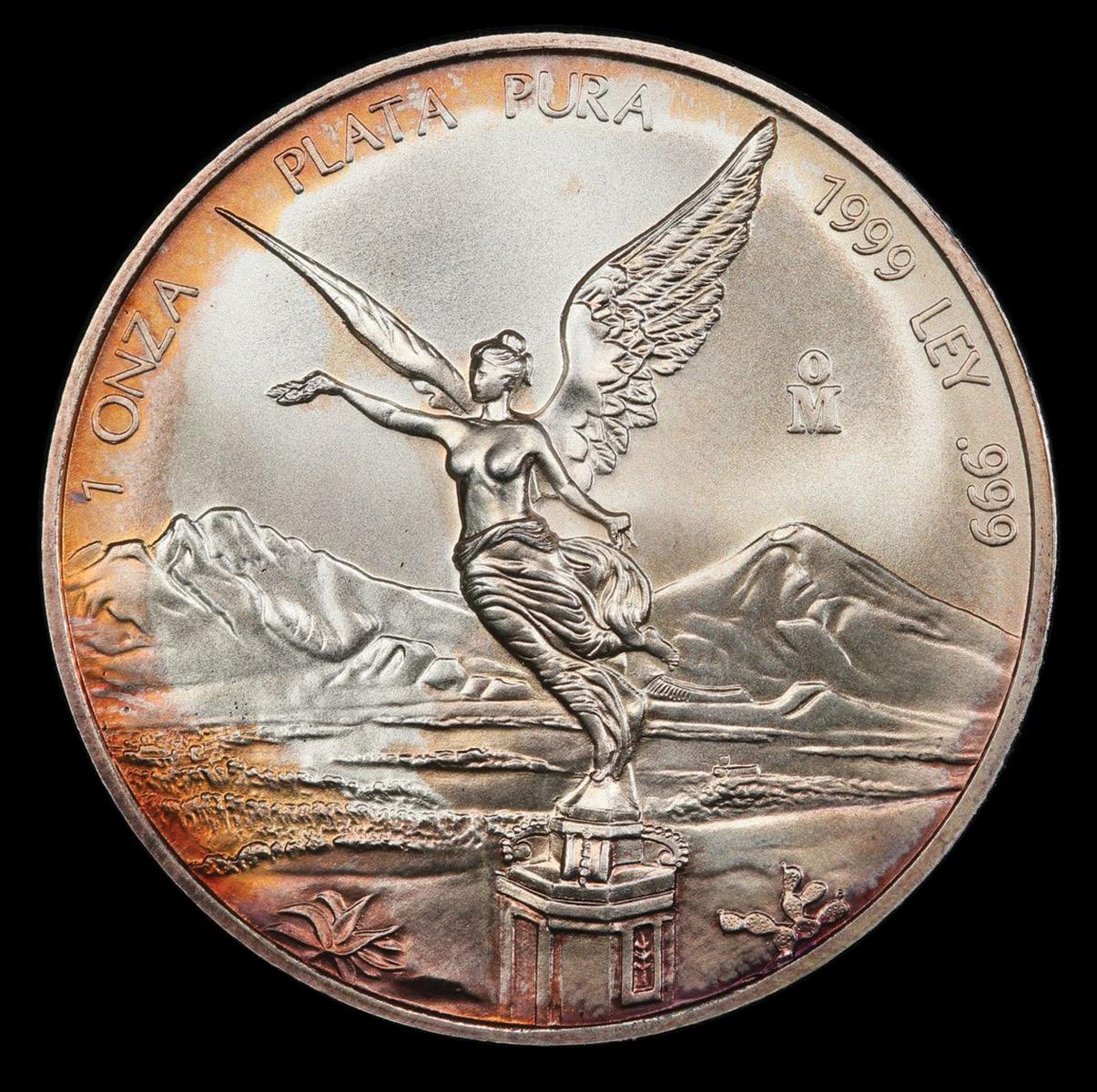

Top: 1999/2000 Mexico Onza Libertad Mule, PCGS MS67
Middle: 1999 Mexico Onza Libertad, PCGS MS69
Bottom: 1999/2000 Mexico Onza Libertad Mule, PCGS MS67
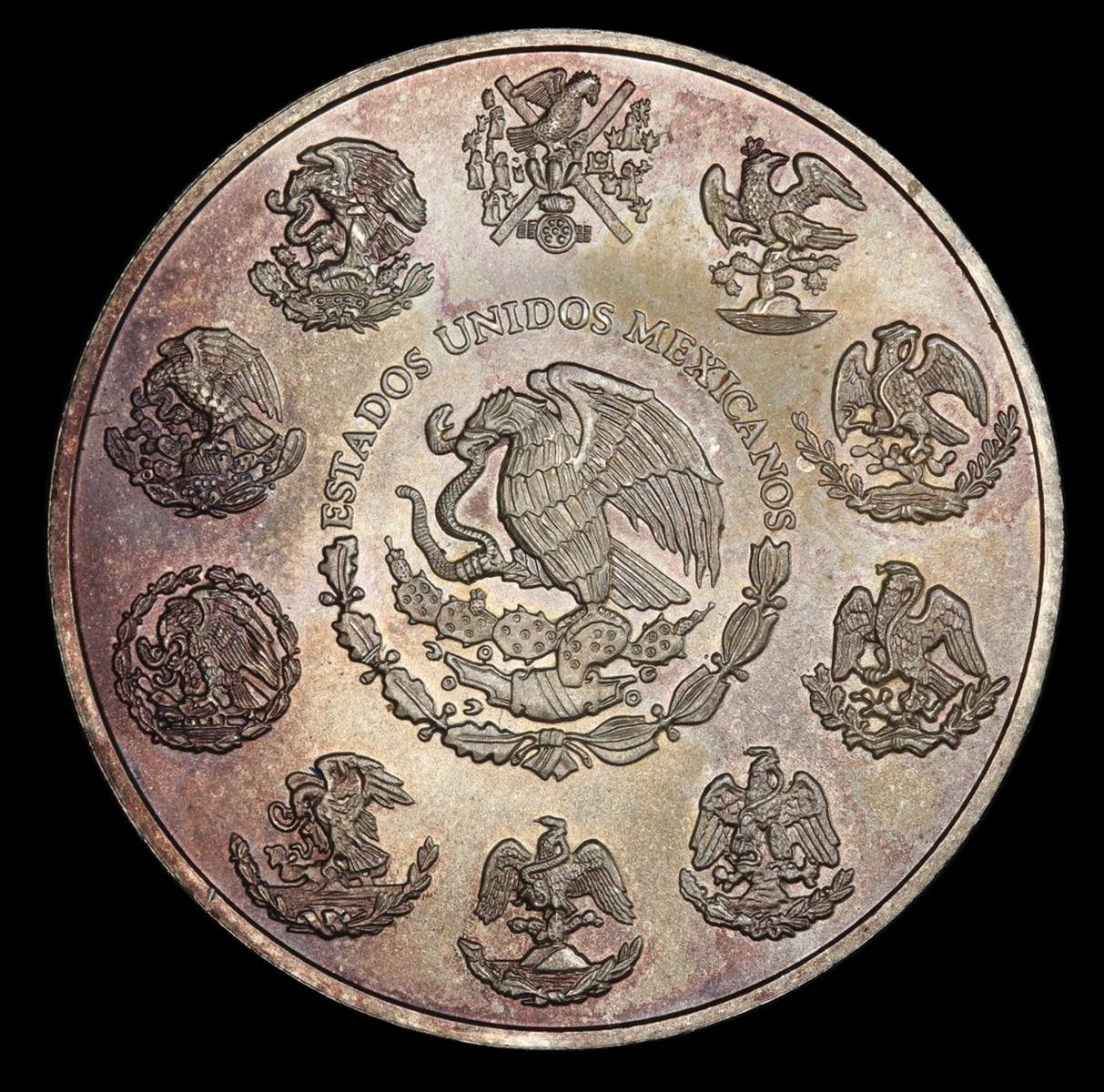
Starting in 2008, the mintages for the Onza Libertad increased significantly from the previous years and then dropped below the one million mark beginning in 2012. Keep in mind that the price of silver reached a price of $48.70 per ounce in April of 2011, the highest price achieved for the precious metal since 1980. Silver prices saw a steady decline for the next several years. Onza Libertads from 2008 through 2024 graded PCGS MS69 can be purchased for $150 or less, and sometimes for as little as a 25% premium over the spot price of silver. Minting technology has also improved over the years at the Banco de México, which has translated into more MS70s being graded. In 2015, coin rolls issued from the mint now consisted of 25 coins in a plastic tube instead of the 20 coins issued per roll in cardboard, as was the case since 1982.
Popularity of the silver Onza Libertad continues growing at a brisk pace. Since the beginning of 2025, prices for scarce issues have substantially increased, though premiums may be cooling as the year draws to a close. However, if silver were to rise to $50 per troy ounce, prices for Onza Libertads would increase accordingly. The 1991 Type 2 OnZa Libertad seems to have passed the standard 1998 Onza Libertad issue in terms of PCGS MS69 pricing.
In the long run, price rises may continue as more Onza Libertad collectors enter the marketplace. The scarce 1998 Onza Libertad “Die Chip on Eagles Head” will more than likely also continue its ascent as demand ramps up and collectors aim to complete PCGS Registry Sets like the Mexican Onza Libertad Silver with Varieties, Circulation Strikes (1982-present). Finally, the 1999/2000 Onza Libertad Mule is one coin that would be missing from most of these sets due to elevated pricing.
In September 2025, PCGS published an article titled “The Mexico 2025 Silver Onza Libertad Series: Already Elusive?” In the article, we noted that only 300 Onza Libertad were produced for 2025, according to an official release from the Banco de México. This coin remains elusive, however, as of this writing, we still have no clarification as to whether that figure of 300 is a final mintage record for the 2025 Onza Libertad.
Apparently, the 2024 Onza Libertad sold very poorly, and the Banco de México is currently sitting on a cache of unsold coins. This matter did not sit well with Congress in Mexico, and their solution was to cut production drastically. Small quantities of silver coinage were authorized, and gold coinage was not issued. Hopefully, in 2026, production will resume to levels where more collectors can afford the newly minted coins once again.


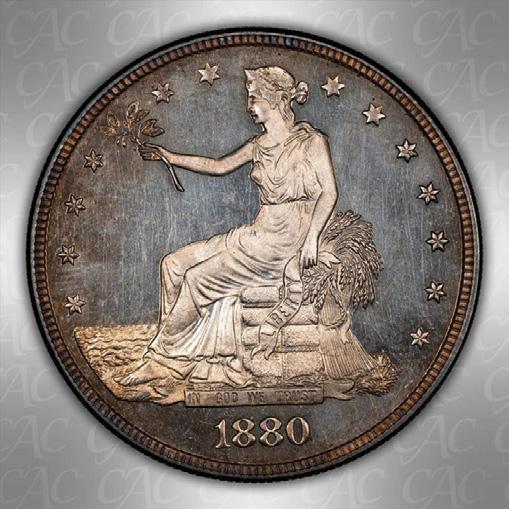
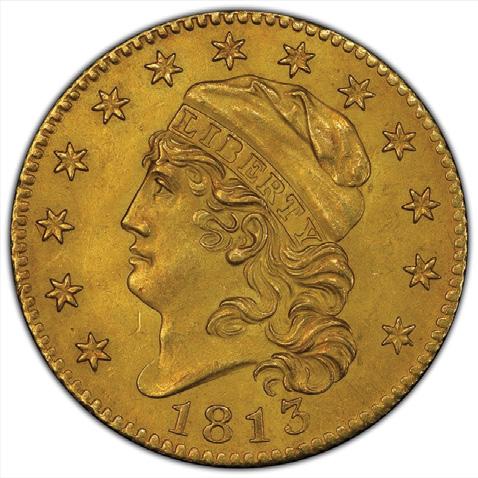


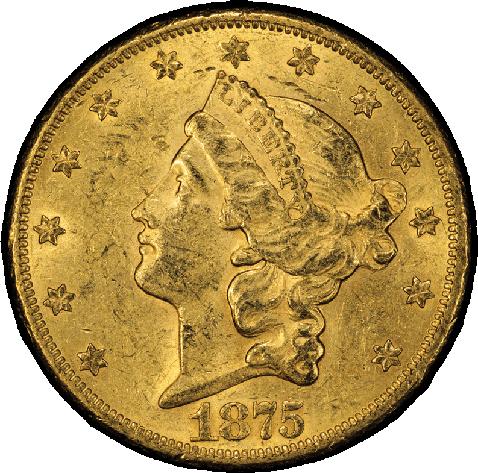
By Vic Bozarth
We’ve recently seen silver prices push above $40 per ounce, and many dealers took notice. During nearly every silver run-up I’ve witnessed over the past 50 years in the coin business, melt values versus price-premium ratios are often overlooked in a rising market. This is something that particularly hits home with Morgan and Peace Dollars, which represent a major portion of the market. Specifications on silver content for these two coins show that each Morgan and Peace Dollar should contain .77344 ounces of pure silver. Meanwhile, the base silver value is more than $30 for any Morgan or Peace Dollar regardless of grade condition.
I really like PCGS-graded common-date Morgan and Peace Dollars in MS62 and higher grades. In relation to their overall melt value, I believe they’re extremely affordable. And in periods when silver bullion prices get hot, so, too, does market potential for generic Morgan and Peace Dollars grading MS62 or better. Ultimately, more attention generates more demand, and with a basal melt value of around $35 each, PCGS-graded Morgan and Peace Dollars in MS62 and better are quite appealing.

What I have seen occur in strong silver markets of the past is that some customers (mainly coin dealers) generally prefer monetized silver coins versus generic bars or rounds. Some of these folks are particularly strong buyers, often wanting to acquire 500 or even 1,000 PCGSgraded Morgan or Peace Dollars in MS64 or MS65.
While hundreds of thousands of PCGSgraded Morgan and Peace Dollars exist, very few dealers would be able to fill an order of 500 or 1,000 such pieces. Many dealers view these coins as something they can always acquire, stocking up on them due to the usually favorable results of previous market events. Ultimately, the amount of capital dealers can tie up in holding generic dollars isn’t attractive

to them unless retail sales of these coins are also strong. But the hope for such results draws dealers to buy these coins in big numbers, especially when prices are as they present themselves for generic Morgan and Peace Dollars these days –especially in the MS62 range.
A major dealer held a massive promotion centered around PCGS-graded silver dollars, and sales far exceeded this dealer’s inventory. Coincidentally, several other major dealers were also short. There was nowhere for prices to go but up, nearly every day for several weeks, until the inventory shorts were filled. When push comes to shove in a rising bullion market, PCGS-graded Morgan and Peace dollars are a great value.
Paying attention to market trends and recognizing how they correlate to current events is crucial for any numismatist – especially when buying and selling popular coins. Am I suggesting you take a position in generic Morgan and Peace Dollars? That’s for you to decide. But at these price levels, I think generic PCGSgraded silver dollars represent great value – especially if silver bullion prices continue to rise.
By Joshua McMorrow-Hernandez
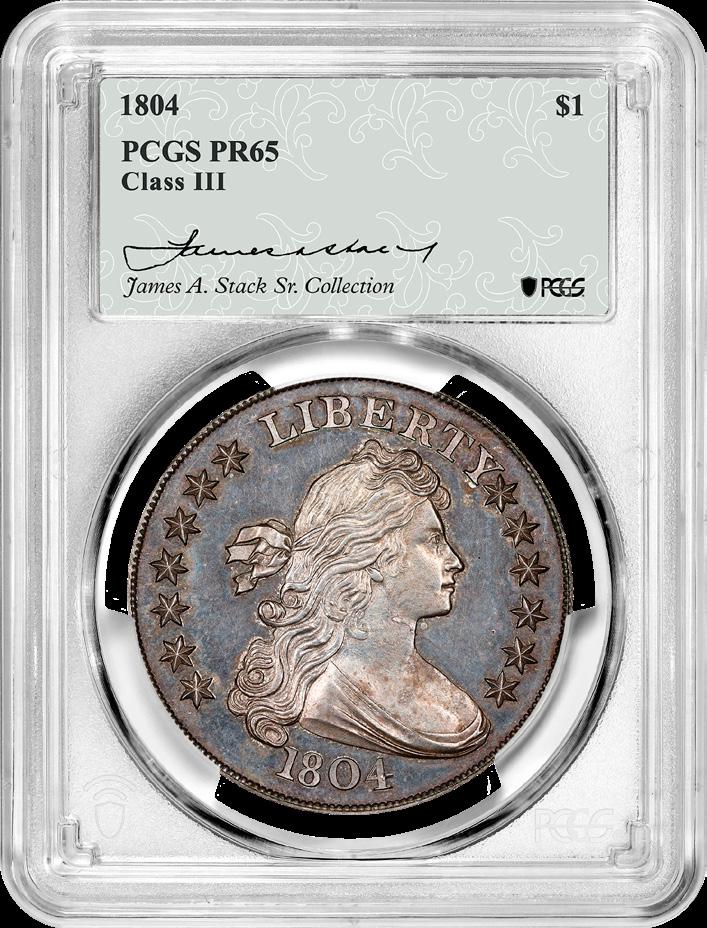
PCGS recently graded an exquisite collection of coins that will soon be offered to the public by Stack’s Bowers Galleries. The coins, which hail from the legendary James A. Stack, Sr. Collection, will hit the auction block in two sales, the first of which will be held in December and the second slated for February 2026. More than 200 coins with a cumulative value of some $20 million will be offered, with many of these being trophy coins of the highest degree. Many of these coins are expected to garner hammer prices of more than $1 million, with one of the most significant of these coins being
a previously unpublished 1804 Class III Draped Bust Dollar graded PCGS PR65.
“We are absolutely thrilled to have graded what becomes the 16th-known 1804 Draped Bust Dollar,” says PCGS President Stephanie Sabin. “For generations, collectors have known of only 15 examples of the 1804 Dollar, including six Class III examples. The news of a 16th specimen stunned the numismatic world and shines a new light on the grandeur and mystique of what many call ‘the King of American coins.’”

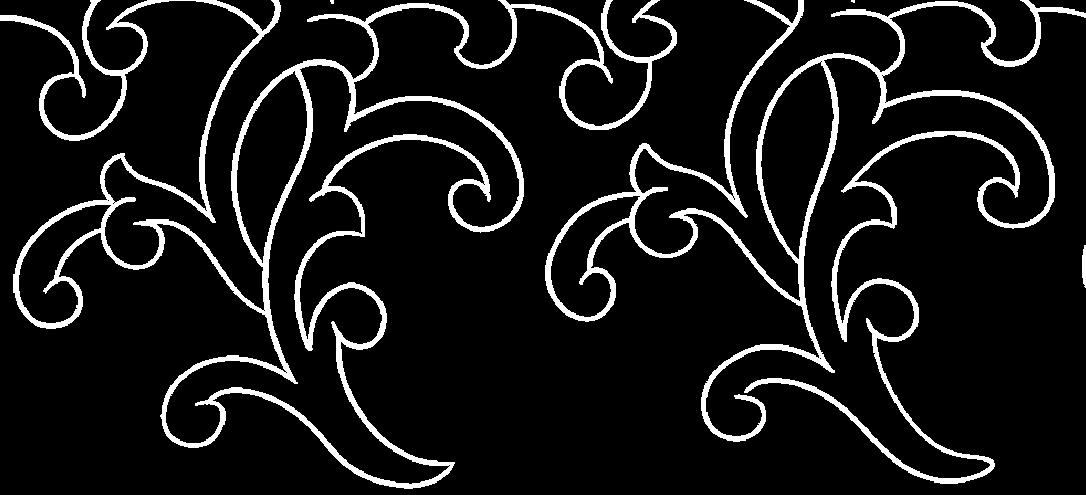
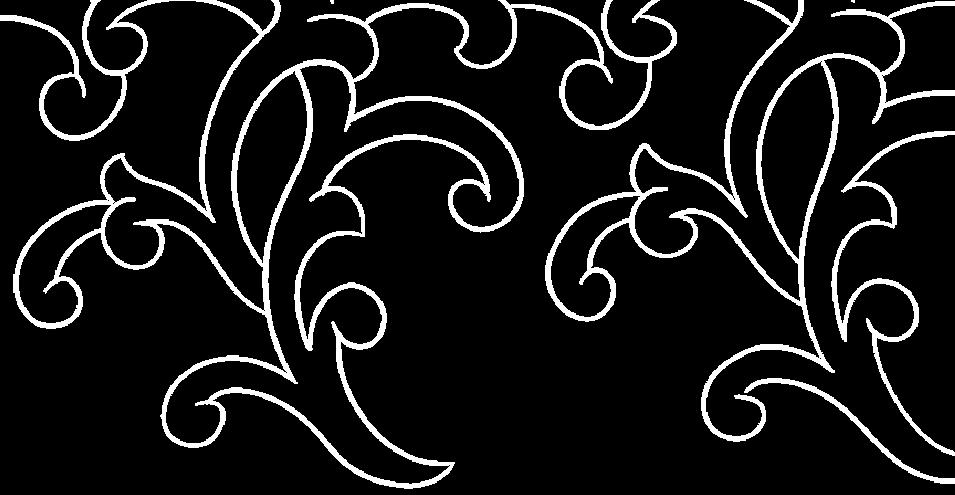
While the 1804 Draped Bust Dollar, one of the most famous coins in all American numismatics, rightfully enjoys the spotlight, Sabin notes there are many other magnificent coins being offered from the James A. Stack, Sr. Collection. “Coins such as the 1907 Rolled Edge Indian Eagle (PCGS MS67), 1795 Flowing Hair Dollar (PCGS MS64), and 1899 Liberty Head Half Eagle (PR69DCAM) brought moments of awe and silence in the grading room as our team evaluated them. These aren’t just rare coins – they’re true numismatic treasures that trace back to one of the greatest collectors of the 20th century.”
Stack, who was unrelated to the prestigious auction house now selling his collection, began building his collection in the late 1930s with the objective of building the most comprehensive American coin collection of his time. He achieved much success as a collector, including the acquisition of the 1894-S
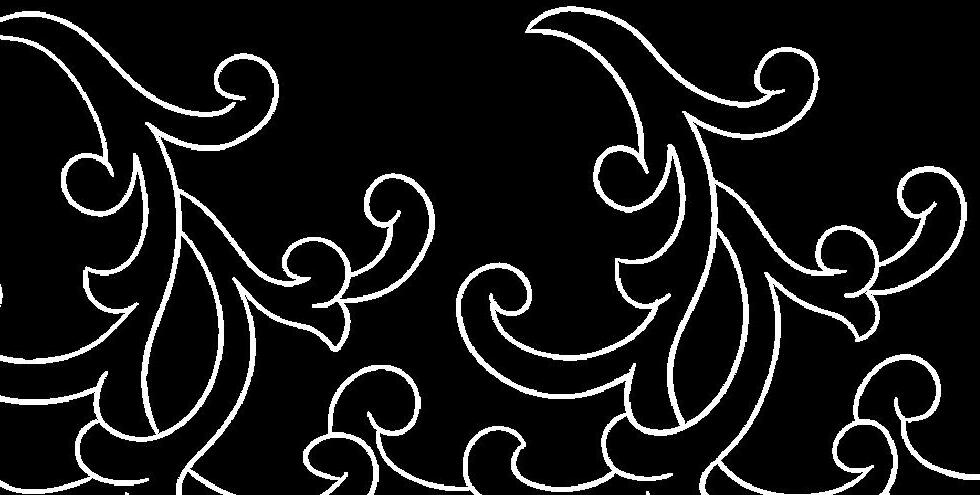
Barber Dime, 1838-O Liberty Seated Half Dollar, and 1870-S Liberty Seated Dollar. Stack passed away in 1951, and his collection has been sold across several auction offerings since the mid-1970s. The two-part James A. Stack, Sr. Collection signifies a landmark moment for the numismatic hobby, as coins that have not been publicly available in several generations are ready for new owners.
“The fact that Stack’s Bowers Galleries chose PCGS to grade these specimens, which are being publicly offered for the first time in at least 75 years, goes to show that the best coins always end up in PCGS holders,” Sabin remarks. Those who wish to learn more about these coins and the two auctions through which they will be offered should visit StacksBowers.com.
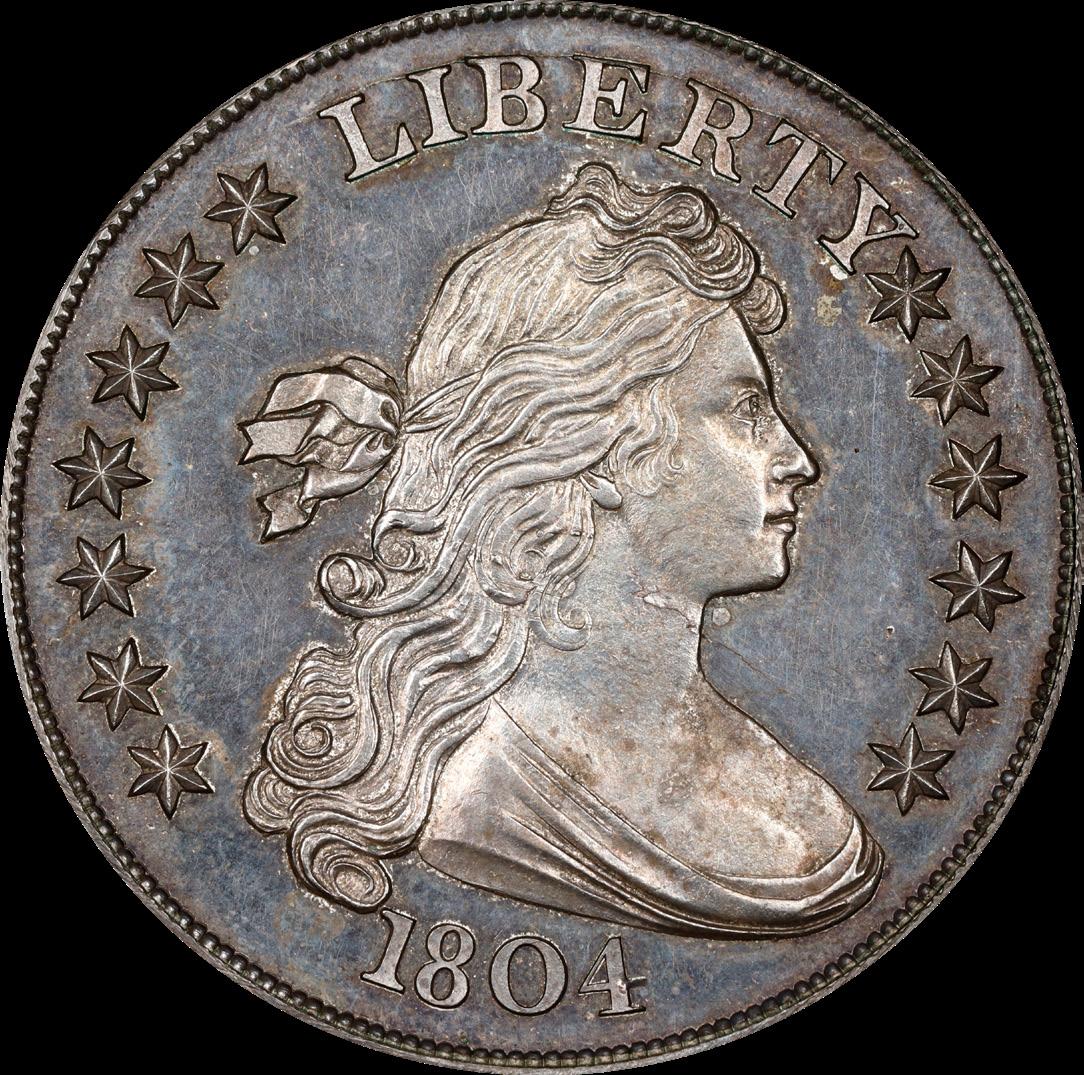



By Keith Dewald
My journey in numismatics and art goes back to my childhood. I was about seven years old when my grandmother gave me a blue Whitman folder album containing about 10 Buffalo Nickels. These coins were less than Fine, and some had dates that were barely visible. Here I was a little kid in the 1980s, and I remember thinking, “Wow, this is what nickels used to look like? Money looked so different than what I got in my change today.”
But those Buffalo Nickels really lassoed me into coin collecting. Growing up on the frontier vistas of the Eastern Sierras, I became obsessed with Western culture –and it only helped that when I got to stay overnight with my grandparents I’d spend the next morning watching Western films with my grandfather, who was a Western buff himself. So, it’s little wonder that my obsession with Western culture fed my love for Buffalo Nickels, which would later parlay into other areas of numismatics.

As I grew up, I also spent a lot of time with my uncle, who was a phenomenal artist and graphic designer. I was impressed with how talented he was, and that rubbed off on me. I was also drawn to art, and it was really one of the few subjects I was good at back when I was in school. So, I’d take all the art classes I could, and I excelled at them. By the late 1990s, my family encouraged me to get into graphic design, but I really didn’t put much thought into it then as a career – it seemed there wasn’t much money in it. Of course, this is back when fine art still ruled, before Photoshop and digital cameras really came into the fore commercially. Not sure what I really wanted to do, I ventured into a variety of pursuits. I was a personal trainer, a boxing coach, a nutrition store salesperson… It didn’t dawn on me until much later – my late 20s – when I thought, “Hmm… Maybe I should pursue graphic design.”
So, I did. I applied to a good graphic arts school, took out loans, attended school full time, had an internship, and worked full time as a gym manager. The amount of homework graphic arts students get is insane. I didn’t get a moment’s rest. There was a point where I thought, “oh my goodness, how do I have time to do all of this?” I dreamed about just having a day to sit on the couch and watch TV. Somehow with zero free time, I reached the finish line – in four years, with honors. I scored some amazing design jobs in the years that followed my graduation in 2014.
When the opportunity opened at PCGS where I could lead the creative side, I was all in. I remember thinking, even before I began working for the company, that if I ever got a job in numismatics, I’d want it to be working for PCGS. I always felt they were the epitome of numismatic organizations. I’m grateful for all the incredible projects I’ve had the opportunity to work on for PCGS… The launch of Near-Field Communication (NFC) anticounterfeiting technology in our holders, the company’s 35th anniversary campaign in 2021, massive redesigns of the PCGS.com website, the
launch of the PCGS online submission center, the overhaul of our company’s magazine and subsequent launch of PCGS Insider, and the recent launch of ancients grading are just some of those achievements.
I was also involved with creating labels for the Harry Bass Collection (which was exhibited for years at the American Numismatic Association Money Museum) contained some of the coolest pieces I’d ever seen – Schoolgirl and Amazonian Dollars, a variety of Flying Eagles, and so many other Judd patterns. And now I’m getting to run with the James A. Stack, Sr. Collection. It’s an honor to be entrusted with a project of this magnitude from start to finish, hands on all the way. And this collection contains a previously unpublished Class III 1804 Dollar? I mean… C’mon! It’s stuff like this that makes my heart full.
Even though I still stay crazy busy with large-scale design projects for PCGS, I have a little bit of downtime – at least a little more than I did back in my days as a graphic arts student! And that gives me the chance to expand my coin collection. I’m actively building a date set of Capped Bust Half Dollars. But my long-term project – the one that really lights my fire –is working on a set of tokens, medals, and coins celebrating the Wild West. It’s mostly 19th-century material, though there are some early 20th-century pieces in there. It features cowboys, rodeos, the Gold Rush, horses – you name it. And I’m so grateful to have buddies who will find something cool – and Western themed – and say, “Hey, Keith, I saw this and thought of you… It’s yours.”
I have a lot of friends who look out for me and surprise me with things that really fit my collection. Maybe one of the coolest pieces? An 1894-O Morgan Dollar counterstamped with the name of Bob Fitzsimmons, a Cornish professional boxer who was in the Guinness Book of World Records as the first champion boxer in three divisions! Fitzsimmons famously countered Irish professional boxer Tom
Sharkey in an 1896 bout in San Francsico that was refereed by none other than Wyatt Earp, the famous Western lawman. Fitzsimmons caught Sharkey in the chest with his “solar plexus punch.” A stunned Earp ruled the incapacitating hit by favored Fitzsimmons a low blow, calling the tilt for Sharkey amid boos from the thousands of spectators.
But that tie-in between boxing, the West, and numismatics? I mean, this 1894-O Morgan Dollar brings so many of these things together into one unique coin – the true prize of my collection. Still, there is another coin I pine for – a Judd-168 or Judd-173, which is an 1855 large cent pattern that carries a vicious-looking flying eagle on the obverse and a wreath reverse similar to what is seen on the back of the Braided Hair Cent.
Maybe one day my collection will be labeled with a Keith Dewald Wild West pedigree, which would be a wonderful culmination of my decades in the hobby. But I’m doing what I do in numismatics for another important reason. I’m not your typical coin collector. I’m an alternative-looking dude with tattoos who is a creative. I want to help open more doors for people who may not fit the traditional mold to find a home in numismatics. And I want to encourage more people to see the value of art in our hobby and help them realize it’s a paying profession. There is no email, no magazine, no brochure, no label without design.
I also hope to leave the hobby and its people in a better place. There are folks on social media who post a drawing they did of an Indian Cent or Capped Bust Half, tagging me in it and writing, “Keith, you inspired me to pick up the pencil and draw again.” And that makes me so happy. I feel like I’m doing something right, even if it’s inspiring someone to get in touch with art. When they’re drawing something that’s numismatic, it’s even more special.
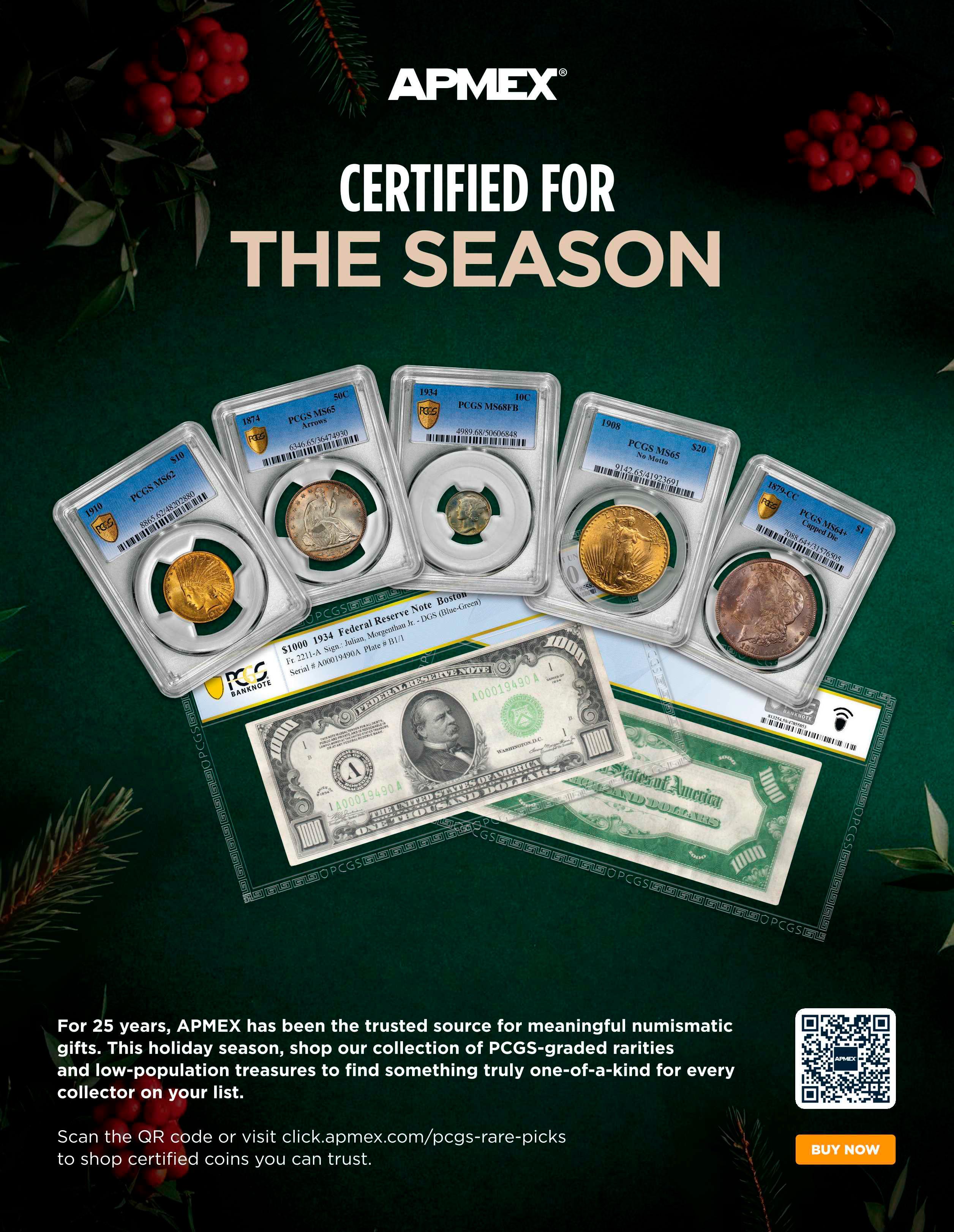
By Abigail Zechman
Isabella I was the queen of two regions of Spain: Castile and Aragon. While not perfect, she was an impressive and powerful ruler who left a lasting impact on both Spain and the New World.
Queen Isabella I was the successor to her brother, King Henry IV. So, when she took the throne, she was tasked with making major reforms to bring her kingdom out of the rebellion and the debt her brother had amassed. Fortunately, she was a woman with remarkable political vision and a deep dedication to her people. She established a police force to help regulate the rising crime in the kingdom and was known for her rigorous pursuit of justice. She also took control of the mints, closed most of them down, and fixed and maintained a legal monetary standard. Her brother initiated an overproduction of coinage during his reign, completely ruining the kingdom’s original monetary standards. Through her dedication to leading her kingdom out of debt, she restored the public’s confidence in the Crown’s ability to handle finances. The queen also set aside time every week to meet with her subjects to rebuild the Crown’s relationship with the people.
In 1492, Queen Isabella I conquered the Kingdom of Granada. Three months later, she agreed to help sponsor Christopher Columbus’ expedition across the Atlantic Ocean. This marked the beginning of a golden age of exploration for Spain, during which the queen reshaped the Spanish linguistic legacy, helping to spread the Spanish language to the “New World.”
In 1933, the World’s Columbian Exposition began in Chicago. A Board of Gentleman Managers and a Board of Lady Managers were established to oversee the event. The Board of Lady Managers was given $10,000 to design a souvenir for the exposition, and they chose to make a commemorative quarter. They were authorized to see production of up to 40,000, but

only 24,214 were distributed, with the unsold remainder being melted by the Mint.
Queen Isabella I was chosen as the subject for this commemorative coin because she was one of the monarchs who helped fund Christopher Columbus’s expedition, which fit with the theme of the fair while highlighting an influential woman. This coin made Queen Isabella I the first named woman to appear on a U.S. coin, and this quarter is the first U.S. coin to depict a foreign monarch.
Originally, Caroline Peddle was going to design the coin. The Board of Lady Managers felt that it was important for the coin to be designed by a woman, and, as a previous student of Augustus Saint-Gaudens and an artist already working on some pieces for the exposition, Peddle was a perfect choice. Unfortunately, she left the project after the director of the mint wouldn’t stop asking for revisions and shot down many of her ideas, so this coin was designed by Charles Barber.
The obverse features a bust of Queen Isabella. She is wearing her jeweled crown and snood. The portrait follows the photographic classicism style, emphasizing her beauty, determined gaze, and impeccable and polished style. The reverse features an image of a kneeling woman holding a staff and spindle, accompanied by the inscription “Board of Lady Managers.” The design is supposed to represent women in industry, highlighting the contributions of women at the Columbian Exposition. The whole coin has a Victorian look, giving a uniqueness that appeals to collectors of U.S. coins.
By Joshua McMorrow-Hernandez

Collectors of early American copper coinage are generally studious, passionate folks who dedicate years searching for just the right pieces to add to their collections. Many also devote countless hours to researching their specific area of early American copper coinage, which spans from the early colonial era into the nation’s formative years. And such pursuits require a curious mind. Enter Allen Ross, a renowned collector of United States large cents who started his numismatic journey drawn to Morgan Dollars – the heavily romanticized silver cartwheels of the Old West.
Ross eventually staked a claim in large cents after a serendipitous social encounter. “Dennis Tarrant, a coin dealer and the father of my son’s friend, noticed I had an 1848 Large Cent,” says Ross. “He introduced me to The Die Varieties of United States Large Cents 1840-1857 by John
R. Grellman and taught me how to use the Date Position Reference Numbers (DPRNs). His guidance sparked my fascination with attributing late-date varieties.”
Before long, Ross became a member of the Early American Coppers, the preeminent numismatic society for those who pursue coins like United States large cents. His research contributions to the organization’s census data became a full-blown passion for Ross, who went all in on diestate collecting.
“The challenge of attributing late dates became addictive,” he says. “I started focusing on Newcomb varieties. Over time, I became interested in die state progressions and unattributed rare varieties became one of the most rewarding parts of the hobby.” Ross cites the challenges of collecting the niche that fuels his interest. “While a couple dozen people have claims to complete the early date (1793-1814) collections by Sheldon Numbers, no one has yet completed the late dates by variety.” This is not to say that late dates are Ross’ only focus. “Though I started with late-date large cents, my focus eventually expanded to include early dates, especially those from 1794.”
Citing a litany of influential individuals in his field, Ross remarks on the pursuits of the late Walter Husak, who – like Ross – was heavily involved with building legendary sets of United States large cents. Husak, founder of the Liberty Cap Foundation, owned the gamut of large cent rarities, including those from 1794. Among Ross’ favorite coins is the 1794 S-67, whose die defect appears as tears dripping from Liberty’s eye.
A true collector’s collector, Ross has dedicated years to better understanding large cents and enjoys sharing his knowledge with others. Along with his contributions to the research database for the Early American Coppers group, Ross has also helped update a recent edition of The Die Varieties of United States Large Cents 1840-1857, a seminal reference by John R. Grellman, Jr.
Collecting large cents today helps provide Ross with a unique perspective on current affairs in the numismatic world that pertain to the modern cent, the production of which is currently slated to be phased out in the coming months. “I believe the end of large cent production in 1857 helped ignite the original interest in the hobby,” Ross remarks. “Today, with inflation rising and electronic payments replacing pocket change, the U.S. cent’s demise is inevitable. As that chapter likely closes, I hope it inspires a renewed appreciation for these coins — and the history they carry.”


Nineteen-year-old collector Ross Koenig got his start in the hobby at the age of 12 when he found a 1894 Indian Cent while searching through change with his grandparents. What began as a chance discovery is turning into what this young numismatist hopes is a lifetime pursuit. “A lot of support in the beginning from my parents, local coin shop, and the American Numismatic Association (ANA) young numismatist program kept me engaged, especially as the COVID-19 pandemic caused clubs in my area to shut down,” he recounts. “Most of my time collecting in the beginning was spent coin roll hunting.”
The college sophomore pursuing chemistry and Jewish studies also loves American history. And that draws him toward collecting primarily U.S. coins and banknotes, with a primary focus on building a U.S. type set. “As the history of coins is what I enjoy the most, collecting all dates or mintmarks within a series interests me less than type sets with a larger amount of variety.” He also enjoys collecting what he calls “conversation starters,” or pieces most people don’t know much about. “I like to collect odd pieces like large-size Silver Certificates, 5 Ounce Silver America The Beautiful
By Joshua McMorrow-Hernandez
Quarters, odd-denomination coinage, and so on. Though they are fun to talk about with guests, I mainly like these pieces for provoking conversations in my own head.” He also strays into world and ancient coinage, but he adds, “The daunting nature of collecting coins from the whole world has kept me focused mostly on the United States.”
Koenig says coins can help him better understand the nation’s past by analyzing the relics of yore. “Being able to hold and own artifacts that are the result of policy decisions of their time is one of the main benefits of collecting coins that continues to keep me interested.” He says another important aspect of the hobby is the network of friends he has built from across the United States. “Because the hobby is smaller than something like collecting trading cards, I’m able to see and connect with the same faces over and over, which has led me to create multiple friendships within the hobby!”
Even with a vibrant network of fellow collectors, Koenig wonders why more young people don’t collect coins. “Talking with friends in high school, most felt that coin collecting wasn’t interesting
or rewarding enough for them to take interest.” But this never deterred the budding collector, who eventually went on to write for the American Numismatic Association (ANA), which eventually landed him the organization’s coveted Young Numismatist Literary Award in 2023 and the Young Numismatist of the Year Award in 2024, not to mention ANA Summer Seminar scholarships.
Recently coming off an internship with Heritage Auctions, Koenig continues sharing his passion for numismatics through writing articles about the hobby, conducting academic presentations in college that touch on coins, and studying metal compositions in college chemistry classes. “By bringing up coins whenever possible, I’ve exposed many people to numismatics who otherwise might never have encountered it.” As his college journey continues, Koenig isn’t sure what his career holds in store. He hopes to pursue a profession as a metal chemist, though he says he’s open to a numismatic career path. “Regardless of where I end up, I definitely hope to stay involved in numismatics as a collector and hobbyist.”
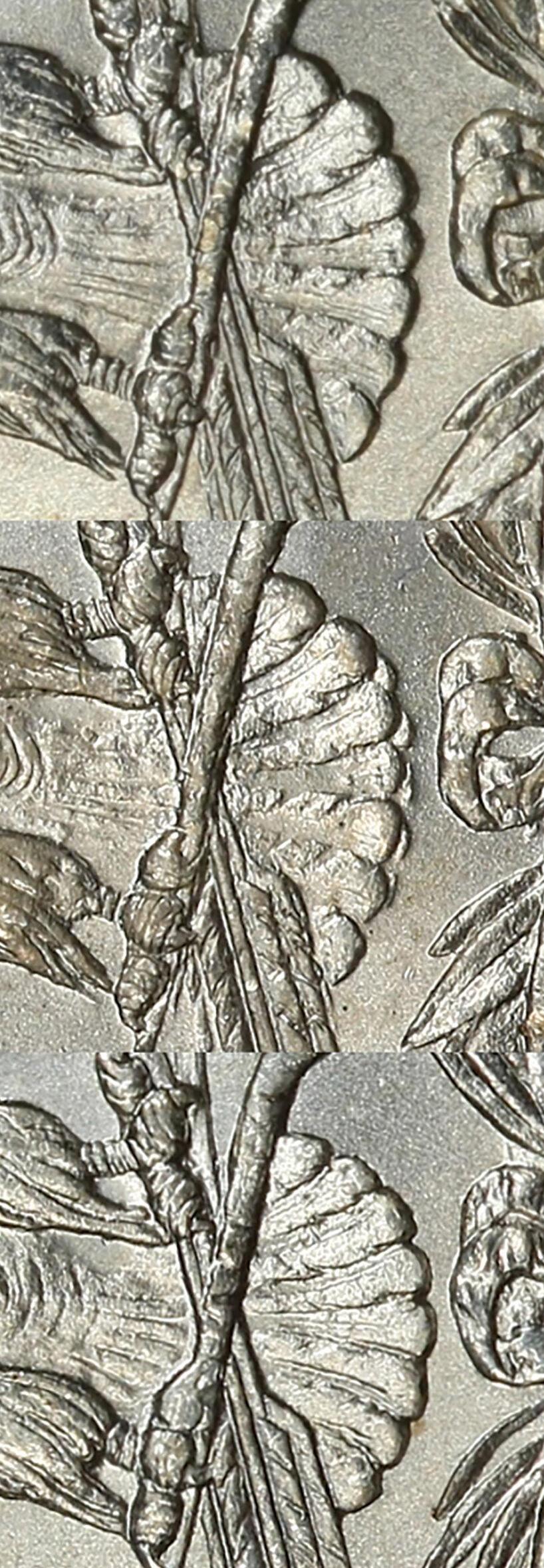
By Edward Van Orden
In the May/June 2025 installment of this column, we featured two different tailfeather orientations of 1878-P Morgan Dollars (as well as the doubled tailfeathers of the 1901 “Shifted Eagle” for comparison). These 1878 VAMs (an acronym for the original cataloguers Leroy “Van Allen” and A. George “Mallis”) are known specifically as the 8 Tailfeathers (8-TF) and 1878 7 over 8 Tailfeathers (7/8-TF). In this edition, we are going to present a few more 8-TF and 7/8-TF VAMs as well as an example of the 7 Tailfeathers (7-TF), the final 1878 Tailfeather orientation used for the remaining years of the Morgan Dollar series.
Left: Comparison of the 8-TF, 7/8-TF, and 7-TF
Of the 41 known 8-TF Morgan Dollar varieties, the one with the most dramatic obverse doubling is found on VAM 5, which is seen on all the letters in “E PLURIBUS UNUM” (hence the nickname “Doubled RIB”). This obverse also often comes with wonderful eye appeal due to prooflike surfaces and cameo contrast. In addition to its own uniquely engraved wing-feathers configuration (as each of the 19 known 8-TF reverses has), this reverse has doubling on “UNITED STATES OF,” “ONE,” and the wreath on both sides of the ribbon bow. Paired with nine other 8-TF obverses, the most obvious diagnostic of this reverse is in the form of a bulge of metal near the base of the “F” in “OF.”
Whereas the obverse is the star of VAM 5, it is the unique reverse of another sought-after 8-TF, VAM 14.4, that commands the spotlight. Not only does this reverse feature magnificent deep mirror surfaces, it is also the most concave reverse of the entire Morgan Dollar series. This striking “Concave Reverse” also has a curious die chip above the left wing tip, a doubled bow with parallel polishing lines inside, and doubling on the bottom of “STATES OF.”
One of the rarer 7/8-TF VAMs is the “7/3” VAM 32 variety. As explained in the aforementioned May/June 2025 article, the United States Mint, having decided to change the tailfeather count of future strikes from eight to seven, overpunched a number of 8-TF working dies with a new 7 Tailfeather (7-TF) hub. The result is 13 known 7/8-TF reverses, which are distinguishable by either extra tailfeather tips or doubling on or around the eagle. Because VAM 32 reveals three tailfeather ends showing below the seven, it is more accurately identified as a “7/3” tailfeather. Additional distinguishing features on this VAM are the diagonal die scratch down from the right cotton boll, a diagonal die gouge through the “I” and “B” of “LIBERTY” as well as a larger one in the upper tailfeathers, and diagonal polish lines in the bow.
Of the over 200 1878 Philadelphia die pairs, more than half of them have 7 Tailfeathers (7-TF), the number that all remaining issues of Morgan Dollars featured. Two of the most pursued and easily identifiable 7-TFs are VAM-115 and VAM-198, which share the same obverse. Although not as dramatic as the “7/5” VAM 44 obverse (also mentioned in the May/June installment), this obverse has clearly defined tripled cotton blossoms. Additional die markers are the doubling of “IBERTY” in “LIBERTY,” “NUM” in “UNUM,” the date, and all of the stars.
Top: VAM 5 Doubled “RIB”
Middle: VAM 32 diagonal die gouge in the upper tailfeathers
Bottom: VAM 115/198 Tripled Cotton Blossoms
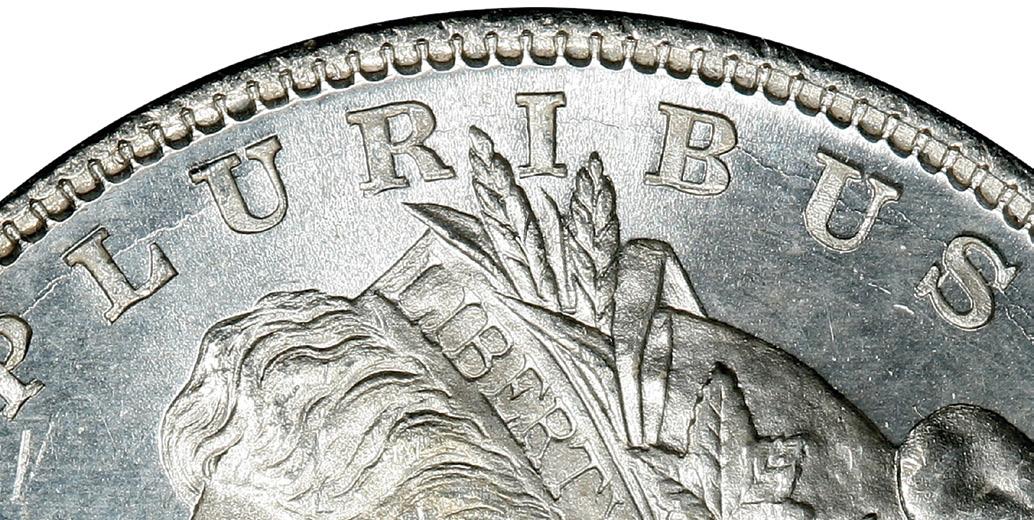


By Jaime Hernandez

We are wrapping up 2025, and the rare coin auction market show no signs of slowing down. Indeed, with higher bullion price levels and strong demand, auction prices realized have been quite impressive on most rare coins. Below are some of the great coins that we would like to highlight.
Bidding was fervent on this coin when it was offered by Heritage Auctions in July 2025. Many people wanted it. This first-year-of-issue Barber Half Dollar is always high in demand across the grading spectrum, especially as a nearly finest known example for both the date and the series. The coin itself is stunning! Interestingly, two of the only four MS67+ examples of this date that PCGS has graded have crossed the auction block since August 2024. The earlier sale offered an exceptionally pretty coin that sold for $18,000. This coin featured here was nicer in terms of its gorgeous, colorful toning and eye appeal, bringing a heftier $21,000.
When Colonel R.B. Mason, acting governor of California in 1848, sent about 230 ounces of freshly discovered California gold to Secretary of War William L. Marcy, neither Mason nor Marcy had any idea of the significance of the 1,389 quarter eagles struck with this gold. On receipt of the gold, Marcy had immediately delivered the gold bullion to the Philadelphia Mint. To denote the significance of this unique striking from freshly discovered California gold, the coins were all punched with the inscription “CAL” in the upper reverse field above the eagle’s head. Surviving specimens are scarce regardless of their grade, with only 83 specimens of this issue graded by PCGS across all grades – just 27 of those coins are in the Mint State grades. Given their slim survival figures, these coins generate much bidder action when they cross the auction block. That was the case with this beautiful AU50 specimen, which brought $66,000 at an August 2025 Stack’s Bowers Galleries sale.
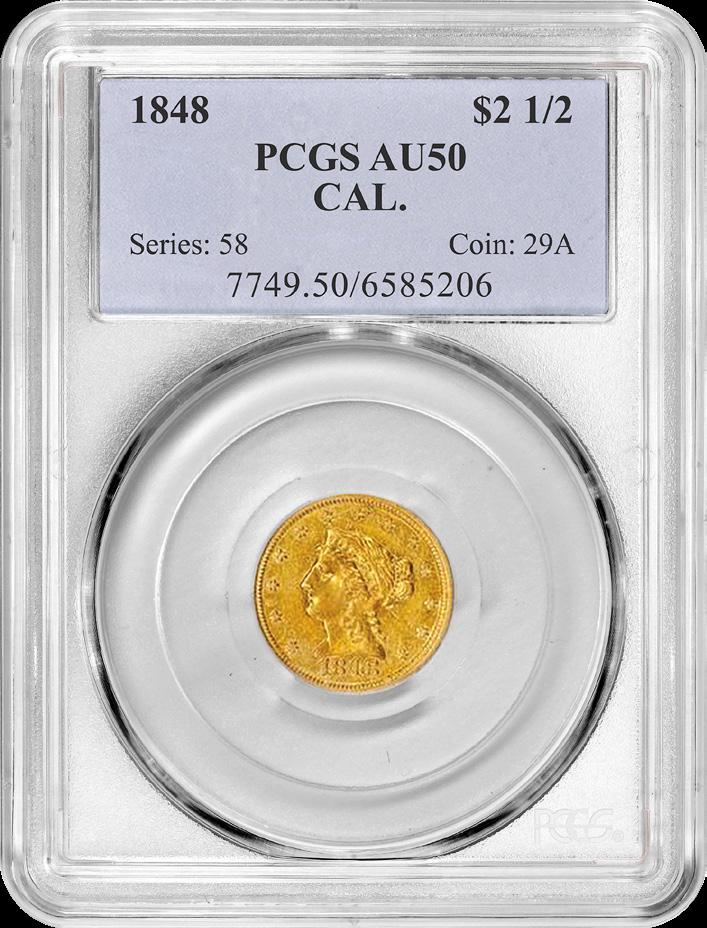

Few coins are as breathtaking as this 1880 $3 Indian Princess graded PCGS PR68DCAM, making it the finest-known example for the entire series. This stunning example is part of the exceptional Floyd T. Starr collection, which included a nearly complete set of proof $3 Indian Princesses assembled between 1937 and 1962. These coins were originally purchased from Wayte Raymond, though the purchase price and date of that momentous transaction are unknown. The Raymond/Starr pedigree as ascribed to the subject coin here is numismatically significant, and furthermore, this example is a rarity of a grand scale, as only 229 PCGS-graded proof examples of the $3 Indian Princess across the entire 36-year series have earned the coveted DCAM designation. The unique opportunity to own the finest known $3 Indian Princess proof with its fabulous pedigree spurred tremendous bidder action, with the coin realizing an astounding $312,000 in an August 2025 Stack’s Bowers Galleries offering.
By Jay Turner
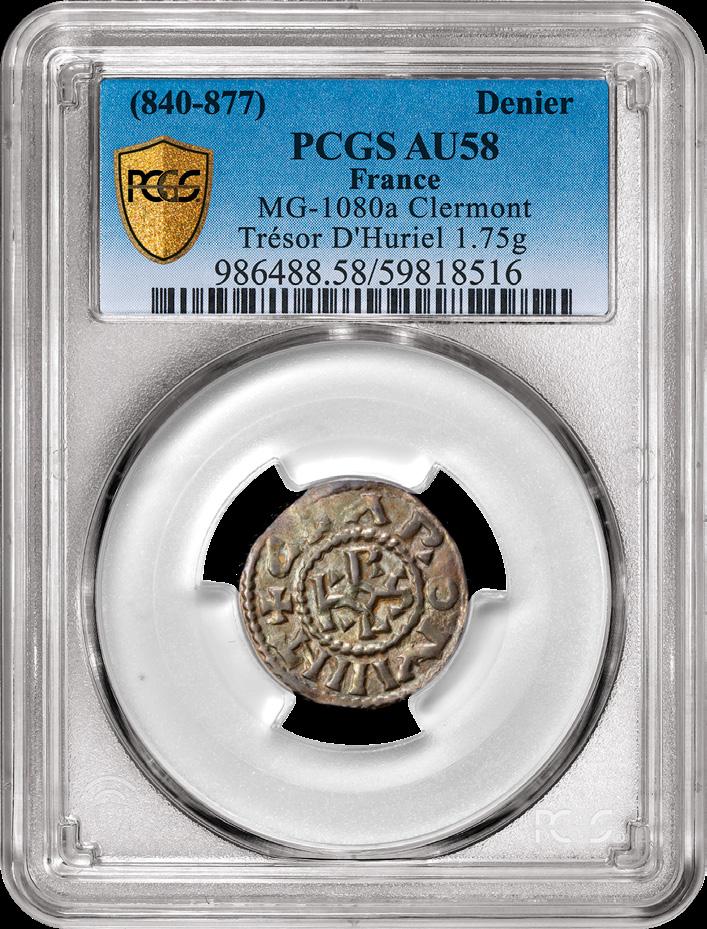
In the most recent on-site grading event at the PCGS offices in Paris, one of the many standout submissions were coins with an interesting pedigree: Trésor D’Huriel. The idea of found treasure is enduring and romanticized across human cultures. From lost artifacts and shipwrecks to buried hoards, the lore and imagination of finding an undiscovered treasure is captivating. Coins from these treasures are often more heavily prized due to the sheer allure of owning a piece of history. So, knowing the pedigree Trésor (or “Treasure,” in English) was something that piqued my curiosity.
The Trésor D’Huriel was a buried hoard of coins from the Carolingian Empire. The hoard was discovered and first referenced in publication around 1905. The coins were found in the region of Huriel, from which the hoard derives its name – an area in the commune of Allier, virtually in the center of France. Believed to be buried between 884-887 AD, the treasure offered a study on coins circulating at this time period. Numismatic study of the hoard was done with coins attributed, recorded, and published.
Many of the coins came from the reign of Charles the Bald, a Carolingian emperor and king who reigned in West Francia between 843-877 and became Holy Roman emperor from 875877. He was the grandson of Charlemagne and the youngest son of Emperor Louis the Pious. It was the Treaty of Verdun in 843 that divided the Carolingian Empire between the three sons, which is considered the birth of the map between modern France and Germany. His reign was plagued with challenges and is often seen as the beginning of the end of the Carolingian Empire. From the rise of feudalism and more dependence on Nobility to relentless Viking raids and forced tributes, there are many issues that may have caused wealth to be buried and found over a thousand years later.
Of the several coins graded onsite at the PCGS office in Paris from this treasure, three of them were plated in a published reference for the Trésor D’Huriel. First was a silver obol of King Charles the Bald, dating from 840-877, from the Bourges Mint reference Dep-195 and plate coin #2. Next was another obol, of the same ruler and mint but with reference Dep-199 and plate coin #6. The third was a denier from Charles the Bald 840-877, yet from the Clermont Mint and listed as MG1080a and plate coin #16. All three coins were graded AU58 by PCGS and designated with the pedigree “Trésor D’Huriel” on the holder.
Quite often, when a treasure hoard is found it is broken up and the information associated with it is lost forever. With the work done in 1905 amid the survey of Trésor D’Huriel and the owners carefully keeping the coins with their referenced pedigree, it was not lost in this instance. Now, with that pedigree labeled and encapsulated by PCGS, the coins and the pedigree will hopefully be protected for generations to come.
By Nathaniel Unrath

The Gilded Age… The phrase evokes tycoons dressed like Scrooge McDuck (or Monopoly game mascot Rich Uncle Pennybags, or Mr. Monopoly) and women in extravagant gowns with outrageous hats in elegant clubs or drawing rooms and sumptuously dressed peers. The Gilded Age, which occurred from the 1870s through the 1890s, is associated with industry, invention, and transportation. The rise of factories, the advent of the light bulb, and the construction of the Transcontinental Railroad are among the many sociocultural touchpoints of the era.
During the Gilded Age, titans of industry – via the new legalistic entity of the trust – created virtual (and often actual) monopolies, thereby becoming associated with their industries to the point of synonymy: Carnegie steel, the Vanderbilt (rail) road, Swift and Armour meat packing… And John D. Rockefeller’s Standard Oil.
The Standard Oil Trust, the first and most influential, eventually controlled 90% of oil production in the U.S. Its assets peaked at around $34 billion in today’s dollars. Rockefeller, at the height of his fortunes, was worth slightly more than $30 billion – that figure also translated into today’s dollars.
On that note, we feature a share certificate in the Standard Oil Trust. This is certificate number 480; it is dated September 5, 1882, at New York City, and made out for 25 shares to “H.L. Davis” (probably Henry L. Davis, who is named in the 1882 Trust Agreement). Printed by the Franklin Bank Note Company of New York, the document’s design is remarkably restrained, even unassuming, given the era and the enterprise, with a standard-style engraved border and a stock vignette of the U.S. Capitol Building in Washington, D.C.
The Franklin Bank Note Company of New York was an engraver and printer primarily of security documents such as stock and bond certificates, although it did print the regional bank issues of some Central and South American countries. Founded in 1877, it was acquired by American Bank Note Company in the early 1880s and then merged with the Homer Lee Bank Note Co. in 1897.
The certificate has been redeemed, with a prominent cancellation stamp and pen cancellations in red on the signatures. The main body of the certificate has been reunited with its stub and reattached. The left edge of the stub shows where it was once bound in a ledger. The back of the certificate has another standard border around a legal clause, also filled out, showing that an individual named Henry T. Davis witnessed the transfer of the shares to Rebecca S. Matthews in 1886.

The signatures on the face are particularly noteworthy: J.D. Rockefeller as president, H.M. Flagler as secretary, and J.A. Bostwick as treasurer. The certificate was also submitted to PSA/DNA for autograph verification, and so carries a dual authentication from PCGS Banknote for the certificate itself and from PSA/DNA for the signature of John D. Rockefeller.
Although not as well known, Henry Flagler and Jabez A. Bostwick also had notable careers aside from Standard Oil. Bostwick was the president of the New York and New England Railroad; Flagler was so instrumental to the development of the state of Florida that some proposed to name the city of Miami after him. (He suggested “Miami” instead.)
Beyond historical artifacts like this, the legacy of Standard Oil is still pervasive. The trust was broken up in 1911, but successor companies went on to become Chevron, the secondlargest oil company in the U.S., and ExxonMobil, the largest corporation in the U.S. and the eighth largest in the world.
By Christopher Bulfinch
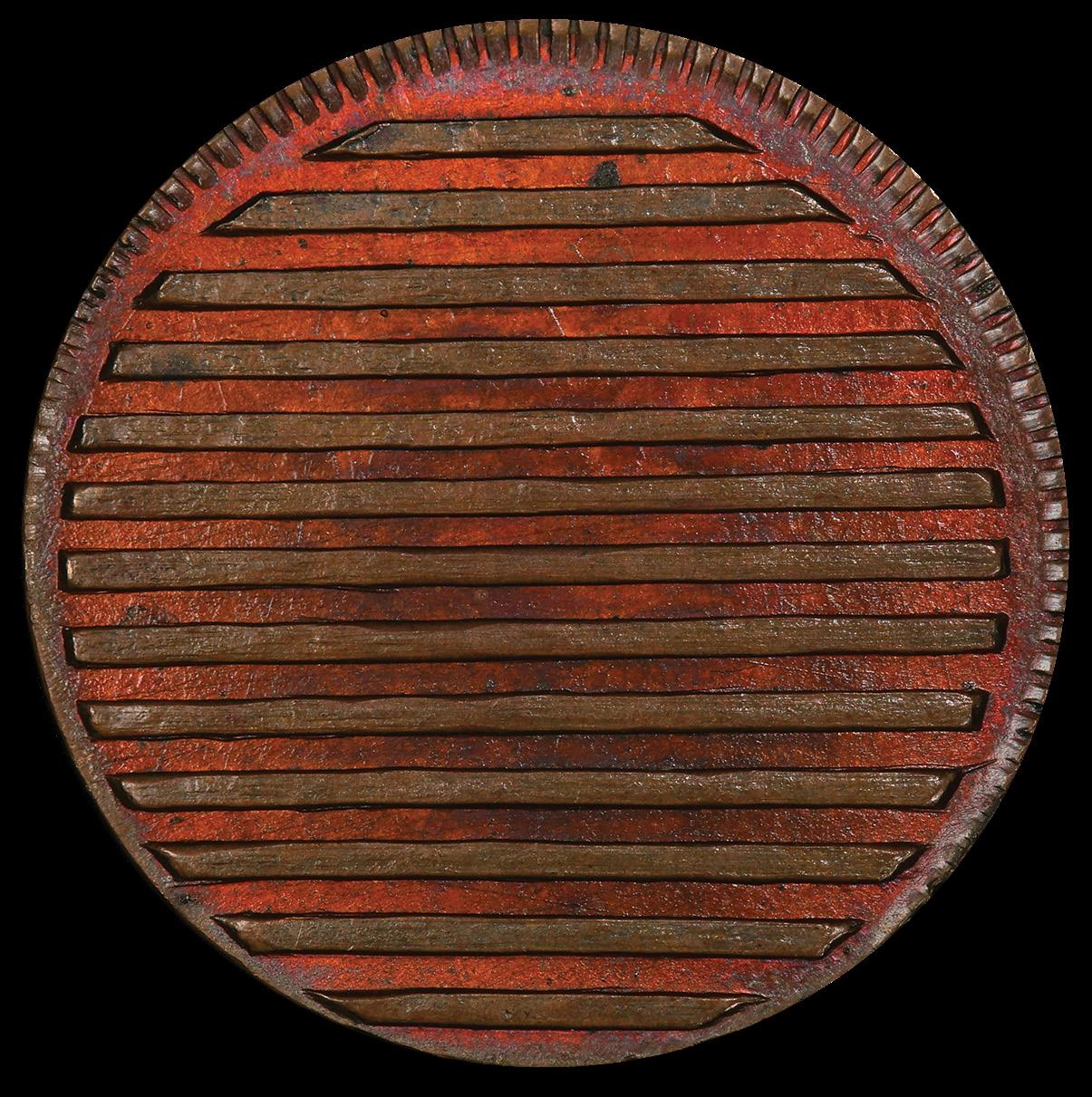
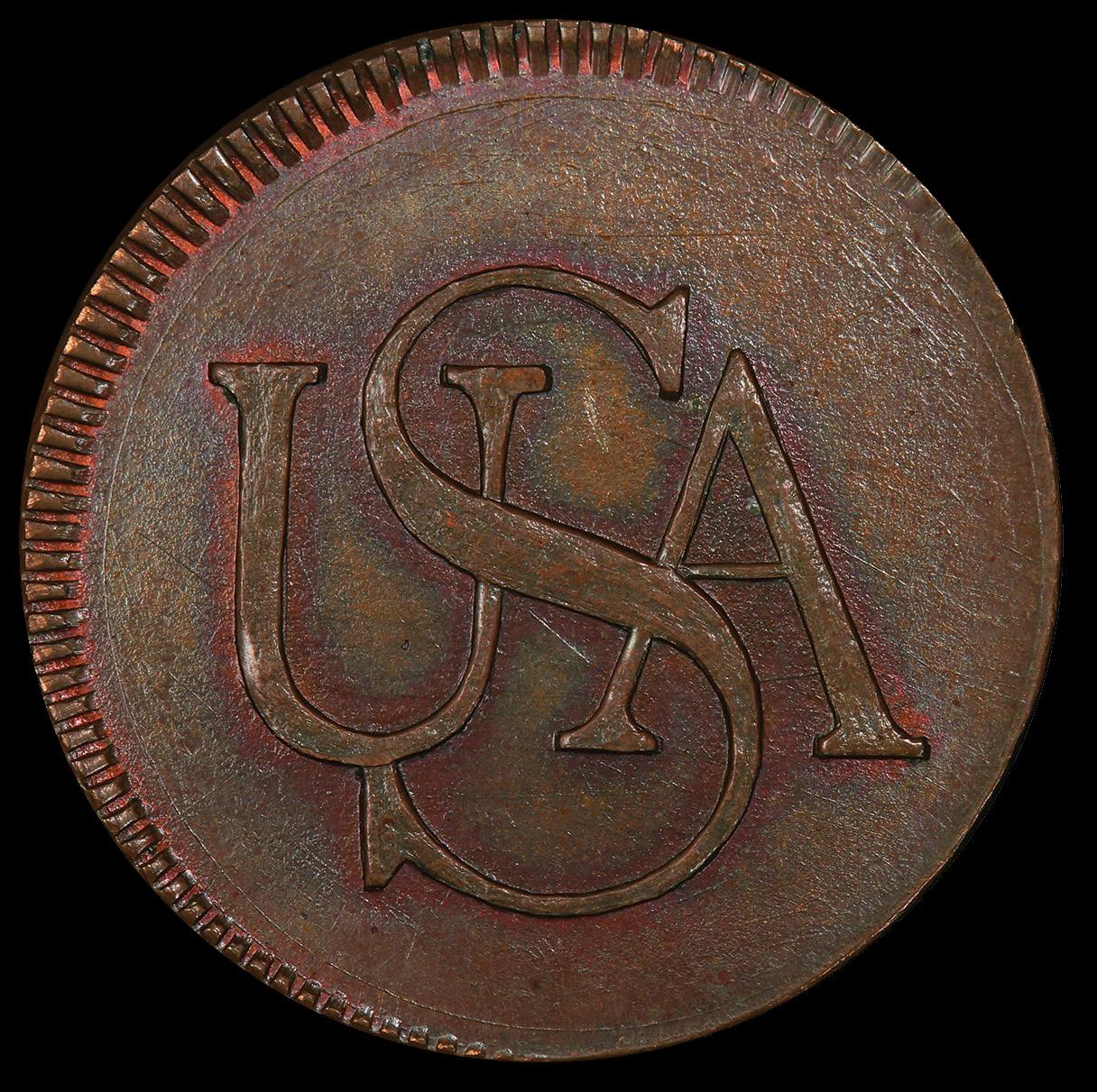
PCGS grades, attributes, and encapsulates a wide variety of tokens and medals, including material by John Adams Bolen, a Massachusetts-based diesinker familiar to many U.S. token and medal collectors. Bolen’s body of work, which includes commemorative medals, copies of famous North American coins dating from the 17th century forward, store cards, and medals commemorating places and events around Springfield, Massachusetts. Produced from the Civil War era in the 1860s to the turn of the 20th century, Bolen’s tokens and medals have been popular with collectors since they were issued. PCGS began grading and encapsulating Bolen material partway through the last decade, and examples of much of Bolen’s output reside in PCGS holders.
Bolen was born in New York City in 1826, moving to Massachusetts as a teenager and settling in Springfield. He would spend the rest of his life in that city. He worked a range of jobs over his lifetime, though his engraving and die-sinking business was his most successful and that for which he is best known, at least in numismatic circles. Pete Smith’s American Numismatic Biographies says Bolen was a member of the Springfield Antiquarian Society and a corresponding member of the American Numismatic Archaeological Society.
Bolen took commissions from a range of clients and undertook some projects on his initiative, notably copies and reproductions of classic North American colonial coins. This effort capitalized on the mid-19th-century coin collecting boom in the United States, as Americans began to uncover their country’s numismatic history, and the well-heeled and well-connected snapped up prime examples. Bolen’s copies afforded those with shallower pockets or sparser numismatic networks the opportunity to own famous coins through faithful, well-made facsimiles, though these struck copies attracted some controversy in their own time.
Neil Musante published the definitive treatment of Bolen’s life and output, The Medallic Work of John Adams Bolen, in 2002. The book, whose catalog establishes the parameters and numbering system of Bolen material that PCGS will grade, was the product of years-long research into Bolen’s life and the availability of his various tokens and medals on the market. In the book, Musante reports that “Bolen gained a somewhat negative notoriety” for the struck copies despite the fact that “right from that start, each copy was well publicized at issue with no intent to defraud, but over time this fact was either forgotten or ignored. “Musante further reflects that “This negative recognition was probably the catalyst that prompted him to issue the 1905 catalog.” Bolen published a catalog describing his entire body of work near the end of his life; he died in 1906.

Musante elaborated that Bolen’s struck copies were “made in order to capitalize on the growing collector interest of the post-Civil War period. He sold them for not a lot of money, say $0.25 or $0.50, depending on the metal. Whatever money he raised, he used to support his own collecting habit, although he was not a buyer of high-end or expensive coins.”
Some of Bolen’s other notable works include a medal for the Pioneer Baseball Club, a Springfield-area semi-professional baseball team; copies of 1780s Bar Coppers; 1730s Higley Coppers; 1690s Carolina Elephant Tokens; and store cards for his own business. He also produced store cards for other businesses.
Some of Bolen’s work depicted landmarks around Springfield including the Armory, where he had worked during the Civil War, the Masonic Temple, and the Pynchon House. Some notable events like the Soldiers’ Fair held in the city in December of 1864 were also subjects of Bolen tokens and medals. He produced medals for organizations in which he was a member or employee, including the Springfield Antiquarian Society and Springfield Armory.
Various combinations of dies comprise a diverse catalog, pairing motifs not seen at the time they were struck, such as an issue in silver and copper pairing an Inimica Tyrannis Americana obverse with a Confederatio reverse, listed as Musante JAB-8; interestingly, this mule was the first Bolen mule certified by PCGS.

Bolen muled classic colonial/early American designs with his own store card, perhaps trying to tie his die-cutting acumen and numismatic products to those avidly collected and eagerly sought by early American numismatists. Bolen sometimes sold dies after he produced a number of examples of a given issue, sometimes defacing the dies before sale. Collectors can, in some instances, determine who struck a given example by the state of the dies, if their state can be determined. Restrikes and overstrikes using original Bolen dies have been produced into the present century, underscoring his numismatic staying power. On some occasions, Bolen’s contemporaries used his dies in combination with their own. George Hampden Lovett, a New York-based die sinker active in the latter half of the 19th century, paired Bolen’s dies with his own, creating mules in two senses: hitherto-unknown pairings of designs, and dies made by two different well-known 19th-century diesinkers.
Bolen’s work occasionally took on a political dimension. He produced medals lamenting the assassination of Abraham Lincoln and supporting the 1868 Presidential candidacy of Ulysses S. Grant.
Many of these pieces, from store cards to the high-quality copies/reproductions of classic North American colonial coins, became collectibles in their own right, both because of the faithfulness of the reproductions, the quality of the engraving and die work, and their relative rarity. Musante writes that, whatever their notoriety, Bolen’s “copies found homes in some of the most important numismatic collections ever assembled.” Some present-day hobbyists and professionals devote their collecting energies to Bolen’s body of work, and his rarest and most sought-after pieces regularly realize multi-thousand-dollar prices at auction.
Copies were Bolen’s strong suit. Richard Wayne Johnson, the first editor of Coin World, a company historian for the Medallic Art Company, and a lifelong journalist and professional numismatist who specialized in art medals, offered this assessment on Dick Johnson’s Databank, a website dedicated to medallic artists: “He was weak creating new designs, but was an excellent copyist. His dies are characterised by stark devices without further symbolism or decoration often with reverses which were entirely typographic.”
PCGS began grading and encapsulating John Adams Bolen’s medals and tokens on December 15, 2013, according to PCGS grader Dylan Dominguez. The first spec number, 522985, is JAB-8, a 1785-dated Inimica Tyranis/Confederatio mule produced around 1863. The intervening dozen years have seen

hundreds of grading events over dozens of types, searchable on PCGS’ online database, PCGS CoinFacts, or the PCGS Population Report.
Bolen material, like tokens and medals broadly, presents graders with specific challenges. Dominguez shares that “JAB material requires individual identification and proper spec attribution for each token and medal. For most Bolen material, we can cross-reference with previously graded examples to verify dies.”
Certification and encapsulation offer attribution and certainty that the graded material is authentic. Attribution and noting of major issues are other advantages. Grades for Bolen material, like much certified exonumia, tend to cluster in the Mint State range, as the pieces never circulated to any meaningful extent.
Bolen material certified by PCGS comes up fairly regularly at auction. In June of this year, Stack’s Bowers Galleries auctioned the Claremont Collection’s group of more than 130 Bolen items, notable among them examples of the Pioneer Baseball Club Medals, a Confederatio Cent muling, and an 1869 copper plate with multiple die impressions.
Most major auction houses that deal with tokens and medals have handled certified Bolen material. Collectors interested in getting a sense of the market would do well to examine the realized prices.

November 5 / November 12 / November 19
PCGS Walk-In Wednesday Collectors Lobby
Santa Ana, California Jersey City, New Jersey
November 6 - 8
Whitman Baltimore Winter Expo * Baltimore Convention Center Baltimore, Maryland
December 3 / December 10 / December 17
PCGS Walk-In Wednesday Collectors Lobby
Santa Ana, California Jersey City, New Jersey
December 16 - 20
PCGS Trade and Grade Showcase * Park MGM Las Vegas, Nevada
January 6 - 10
Florida United Numismatists Convention * Orange County Convention Center Orlando, Florida
January 7 / January 14 / January 21 / January 28
PCGS Walk-In Wednesday * Collectors Lobby
Santa Ana, California Jersey City, New Jersey
January 15 - 17
New York International Numismatic Convention InterContinental New York Barclay New York, New York
Every Wednesday
PCGS Walk-In Wednesday Collectors Lobby
Santa Ana, California Jersey City, New Jersey
February 26 - 28
American Numismatic Association
National Money Show * Savannah Convention Center Savannah, GA
* On-site grading
